We wanted to get on our way by 7:30 this morning, so mindful that Ørslev Kloster has no housekeeper on staff, we got up early enough to strip the beds, clean the sinks, and collect the trash before we left.
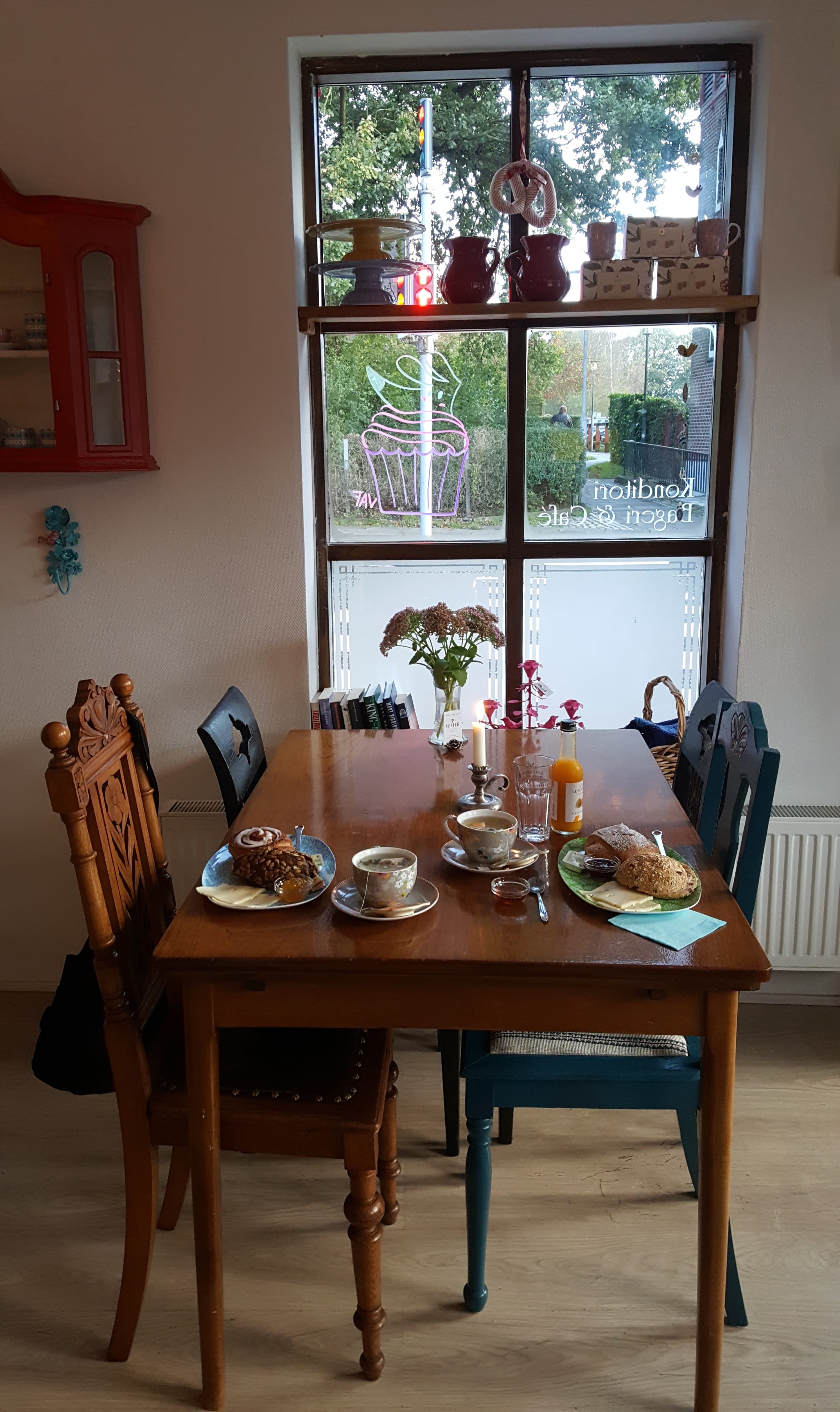
Our table, set with breakfast
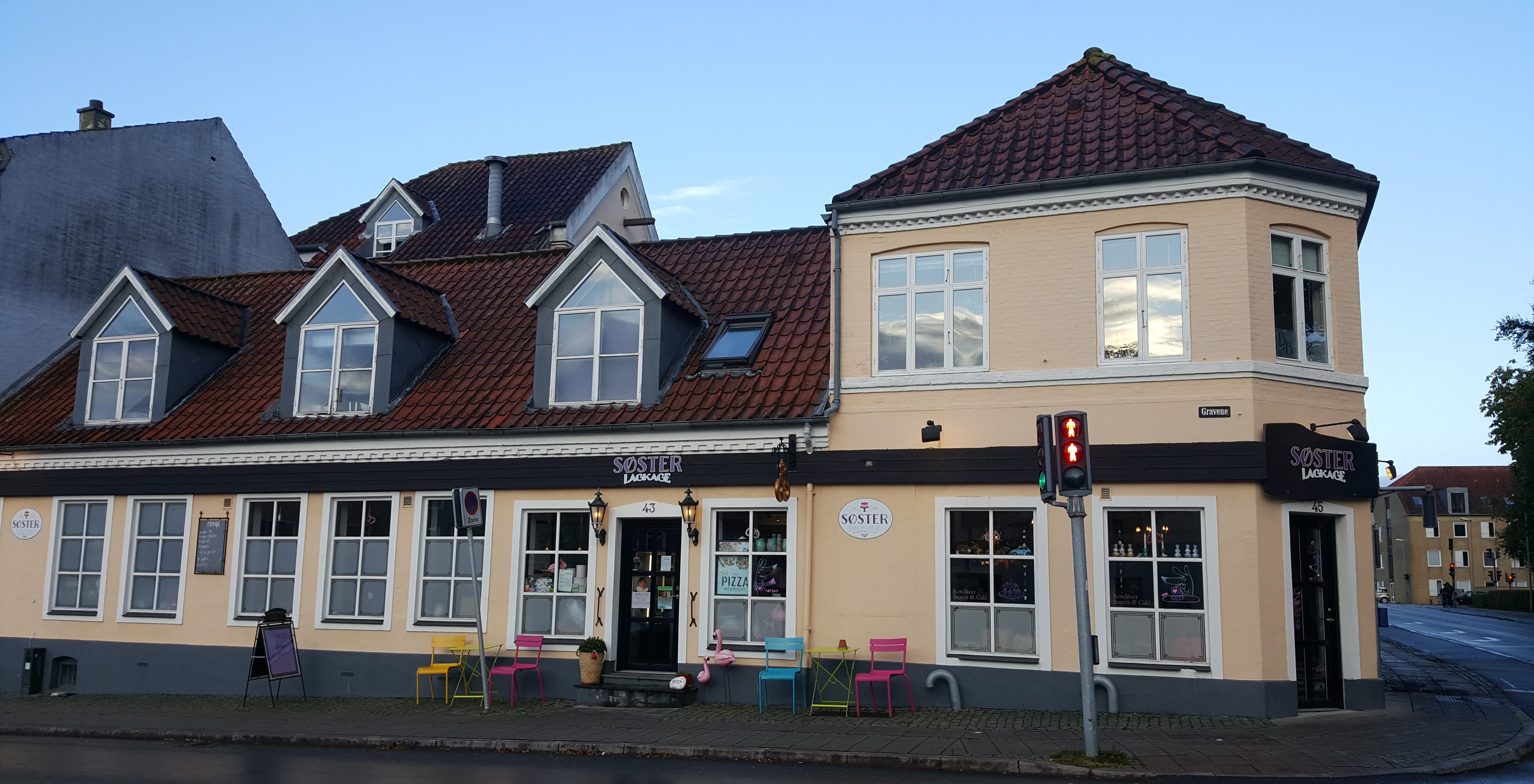
Søster Lagkage
Breakfast was at Søster Lagkage (Sister Layercake), a bakery-café in Viborg, a good-sized town about 30km southeast of the monastery. For DKK65 each, we could get a bun, a pastry, butter, jam, a slice of cheese, and a cup of mint tea. Michael chose a pastry stuffed with apples and marzipan; Nancy was very happy with her cinnamon roll.
This morning we were headed for Aarhus, Denmark’s second largest city, and Den Gamle By (The Old Town). Although it’s located in the center of Aarhus, this is not simply the old section of town, but rather a sort of historical theme park where old buildings from cities all over Denmark have been relocated not only to save them from demolition, but also to give visitors a sense of urban life in the past. We arrived early enough to find a parking space on the street (the website had assured us that street parking was free for up to five hours as long as we displayed our “parking disc”–now we knew what to call that item as well as what to do with it) but not early enough to beat a large group of middle-school students to the entrance.
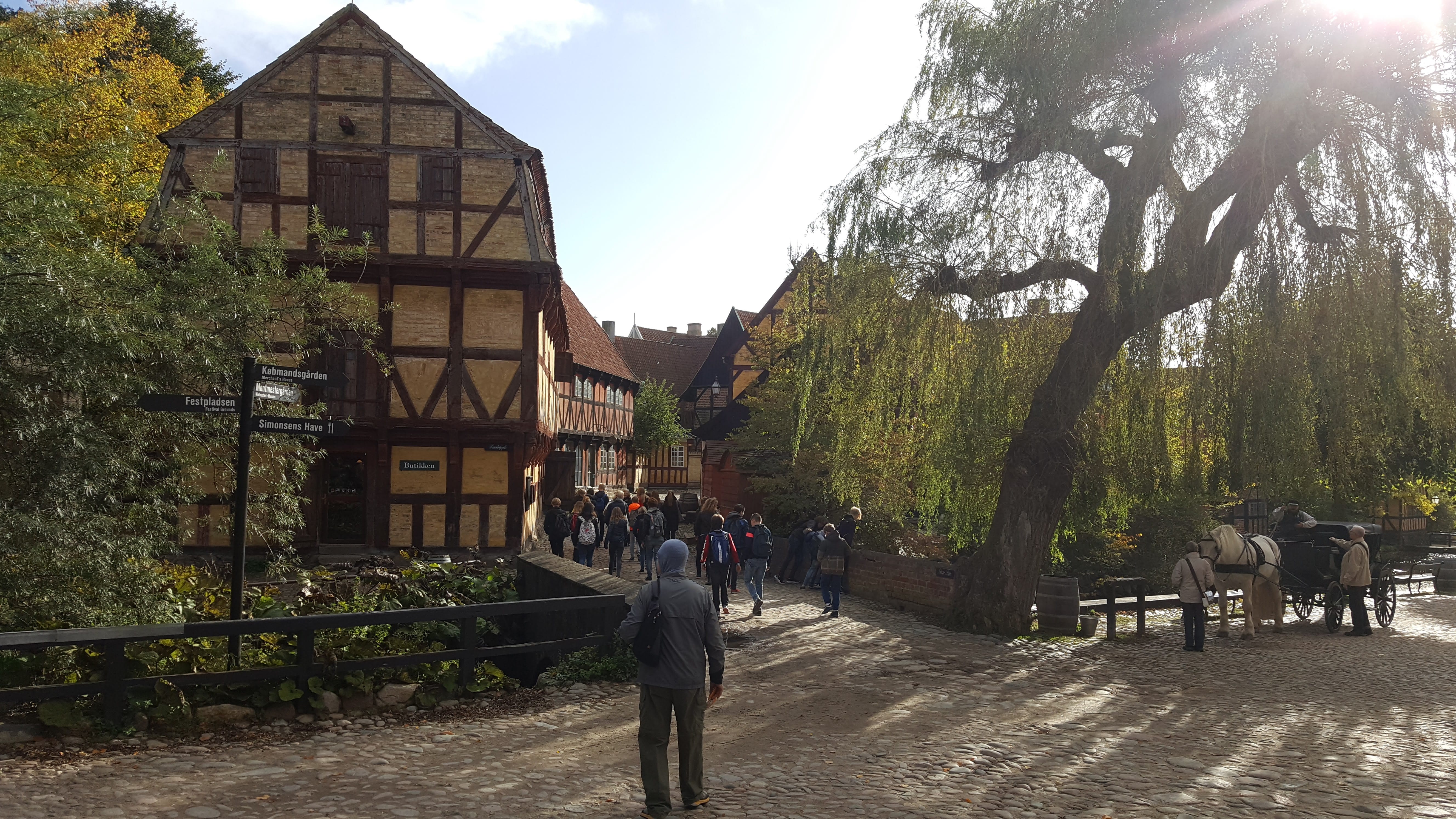
Den Gamle By
What makes Den Gamle By unique is that its buildings are not the former residences of famous people nor the sites of important events; they’re just representative of the homes and workplaces of regular townsfolk. Because this is Denmark, where people are as interested in design as they are in history, the buildings were chosen as much for their architectural significance as for their historic value. They have been situated in groups as they might have been in their original settings, and as you move from street to street, you also move from century to century. It was interesting to track stylistic changes in construction and furnishings as we learned about who had occupied the buildings and what they had been used for.
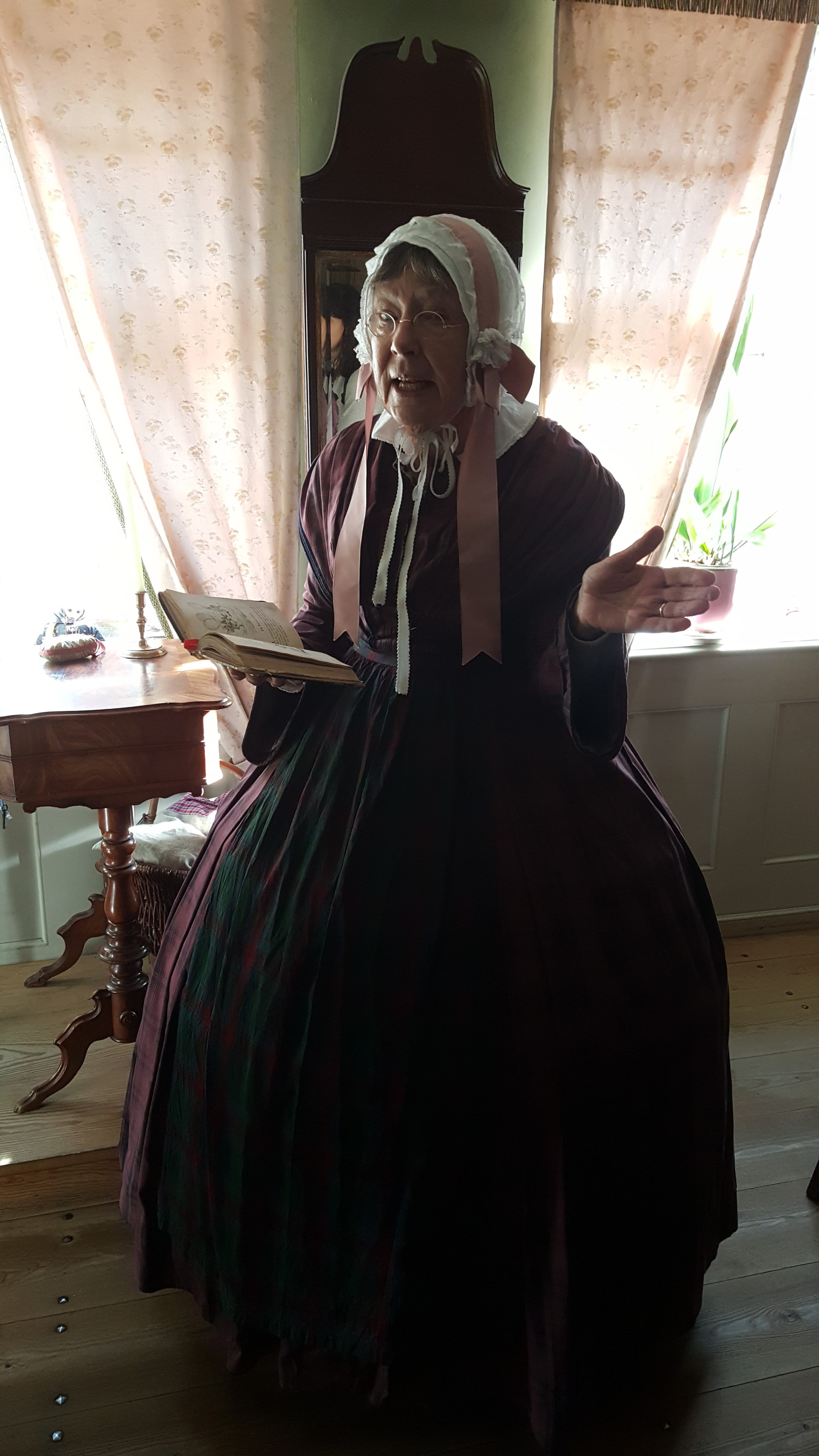
The vicar’s widow

In the widow’s kitchen
The first building we entered was the Eilschous Almshouse, which once sheltered widows and young single women from upper-middle-class families in Odense. An apartment inside was decorated as it had been in the 1860s, when Hans Christian Andersen lived across the street. A docent representing a resident, a vicar’s wife who had been evicted from the vicarage after her husband’s death, told us about having mentored HCA as a child. She then read us part of a story he had written, imagining America as a kind of fairyland with gigantic trees and streams filled with gold nuggets. (Andersen never had a chance to visit the U.S. but he seems to have envisioned California quite accurately, don’t you think?) The docent spoke beautiful, British-accented English, and seemed delighted to share this particular tale with a small group that included an English-speaking family from Tel Aviv as well as the two of us from Cincinnati.
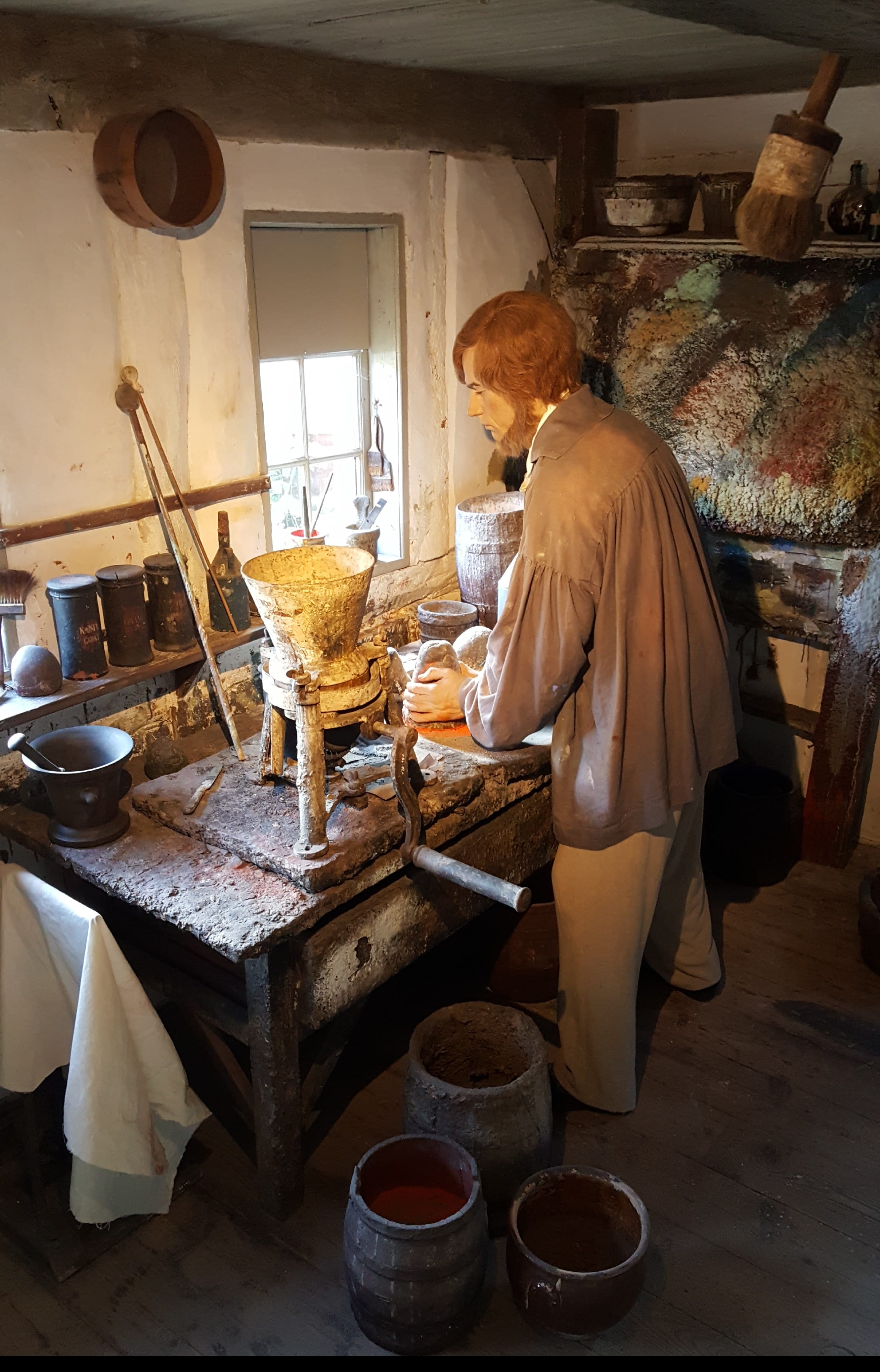
The painter in his workshop
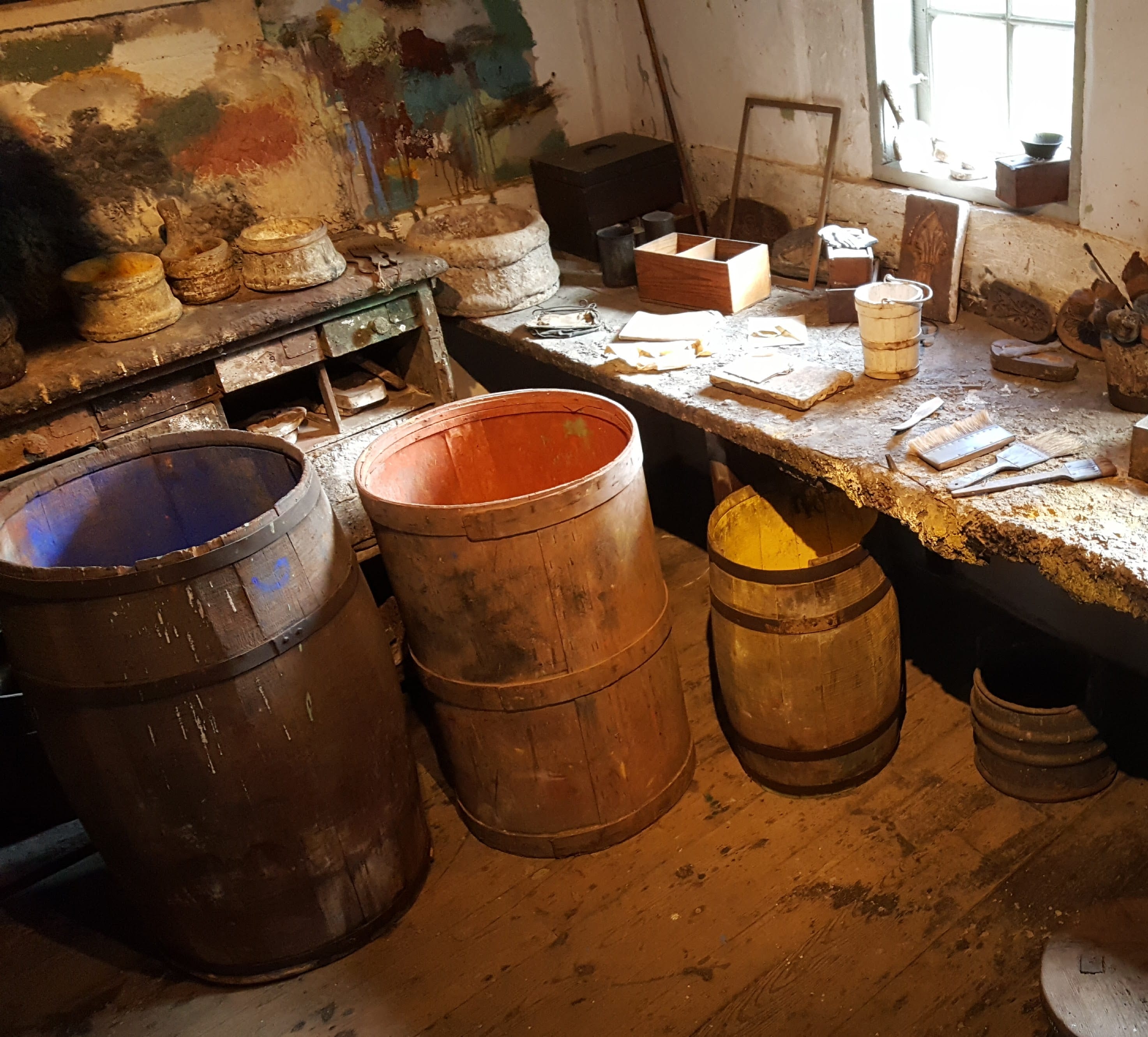
Pigments for his paints
We expected to see more costumed guides in Den Gamle By today, but since this is the off-season we encountered only a few. Many of the old buildings here are peopled by mannequins representing the tradesmen who had worked in them: shoemakers and tailors (both trades that some of Nancy’s Danish ancestors had plied), woodworkers, blacksmiths, milliners, and candlemakers. We were amused by a tableau representing the bedroom of two apprentice carpenters, circa 1839. “Twelve-year-old Oskar has to be the first to get up in the morning,” read the placard, “because he has to light the fire in the workshop and make preparations so that the master carpenter and journeymen can start working. Behind him the 14-year-old apprentice Søren is waking up slowly and reluctantly.” At age fourteen, our own Soren could have been a model for this scene.
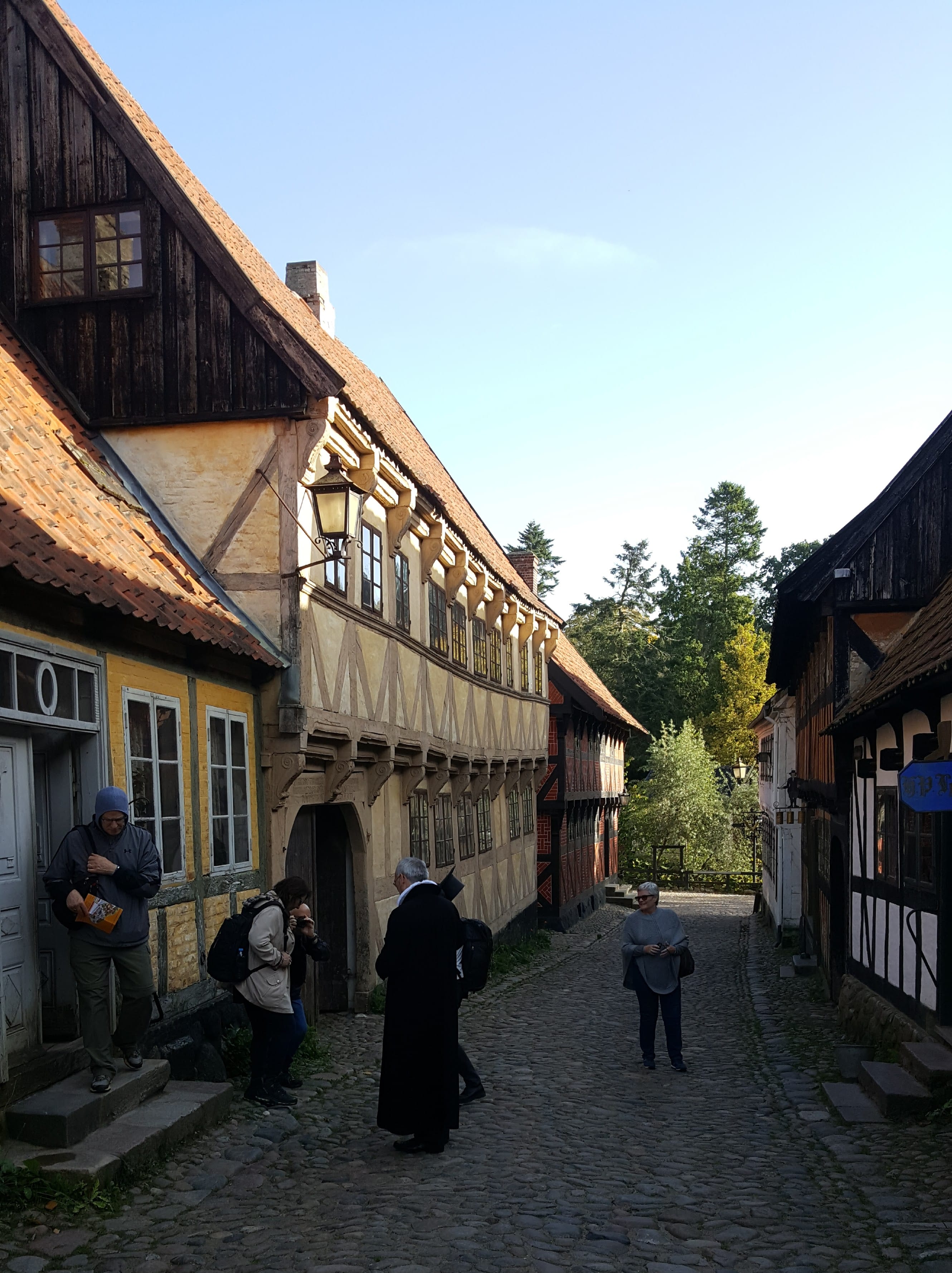
The borgmester (mayor), circa 1600, greets visitors on the street
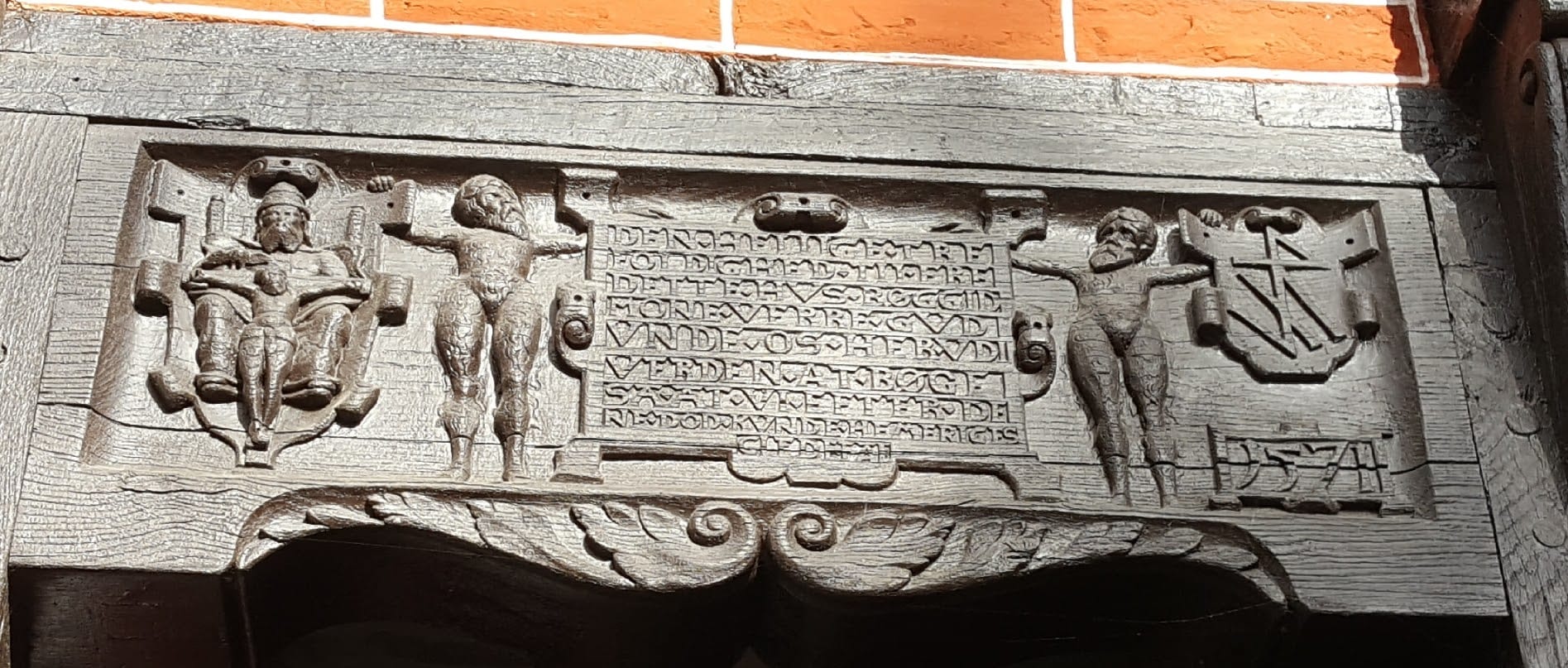
A relief sculpture with runic script over a doorway built in 1571 celebrates a recent military victory
A complex that includes the Mayor’s House is original to Aarhus and was the first preserved structure to be opened in Den Gamle By. It shows how interior styles changed between the late 1500s and 1850. It also includes a number of shops–since the mayor of a town was likely to be one of its merchants.
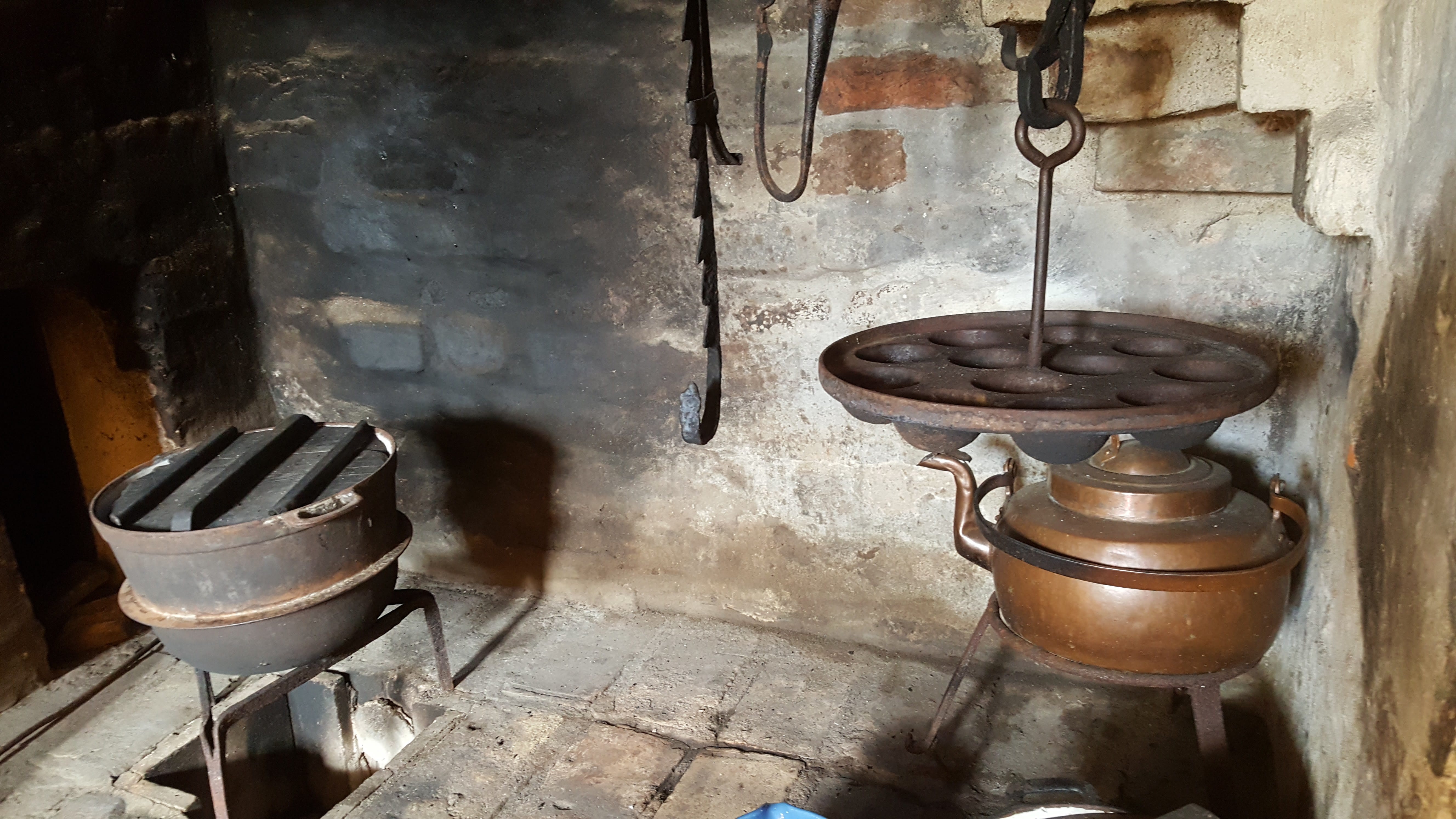
Kitchen hearth, featuring an aebleskiver pan
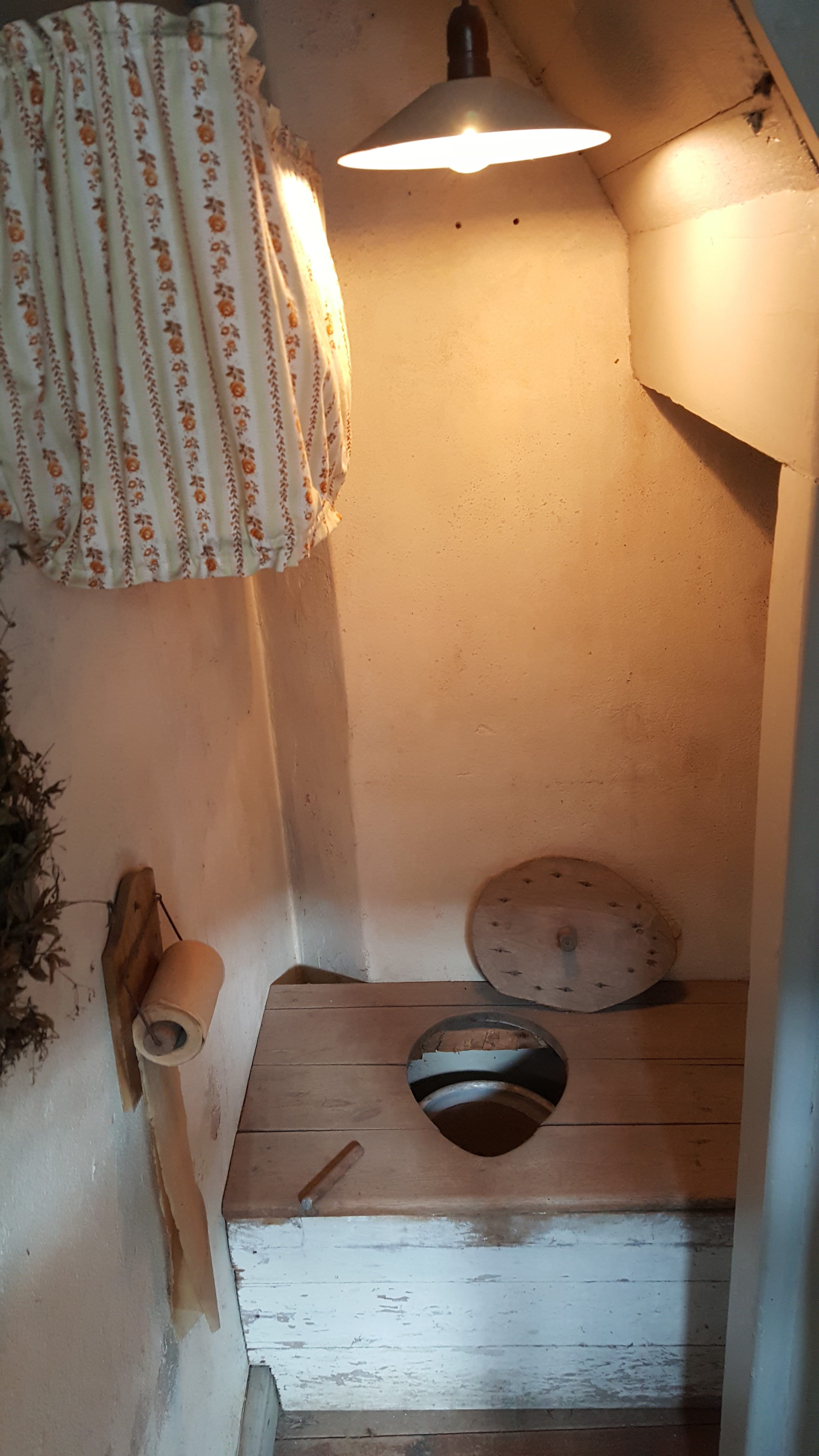
Indoor toilet, circa 1850
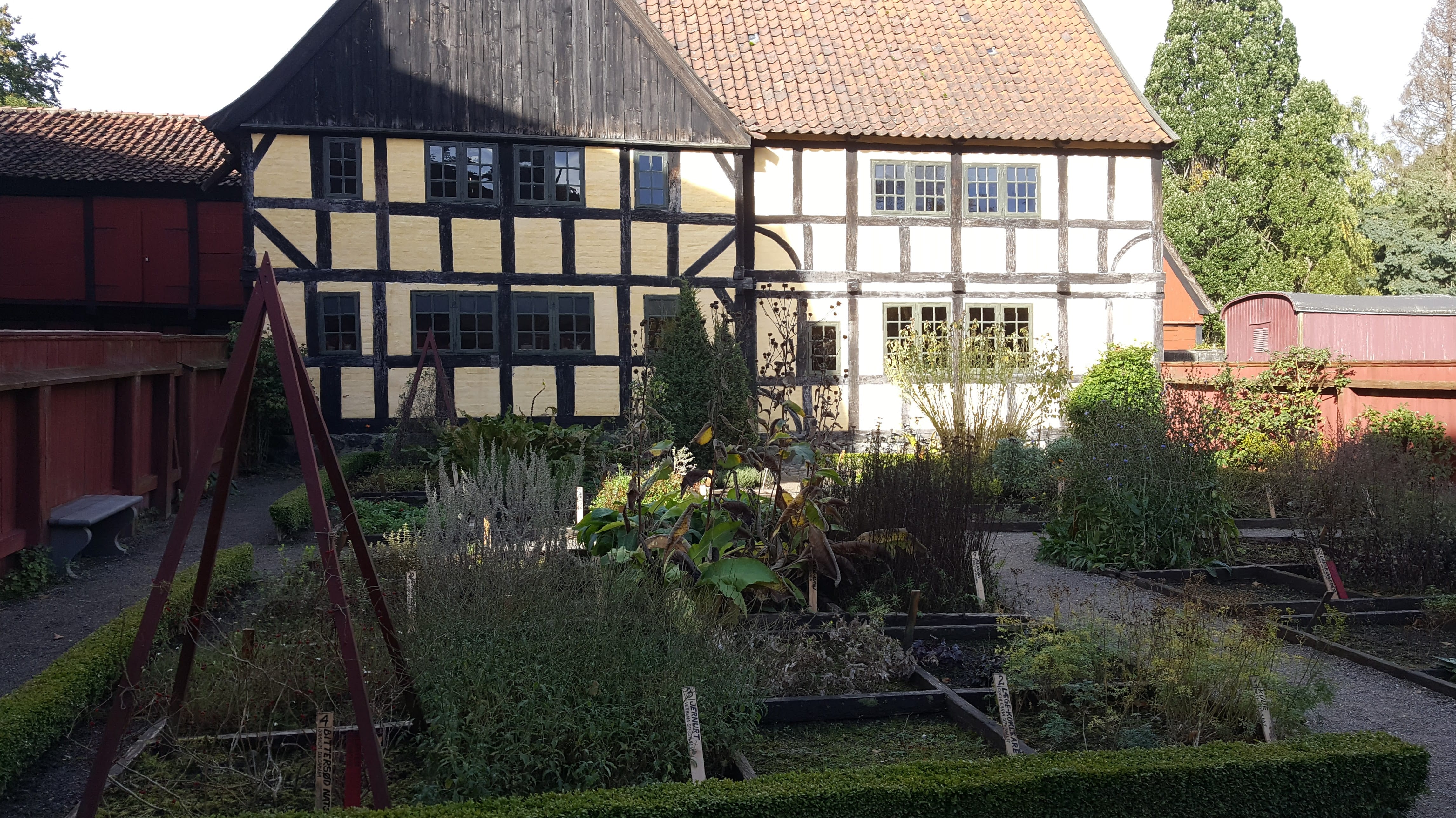
The apothecary’s garden
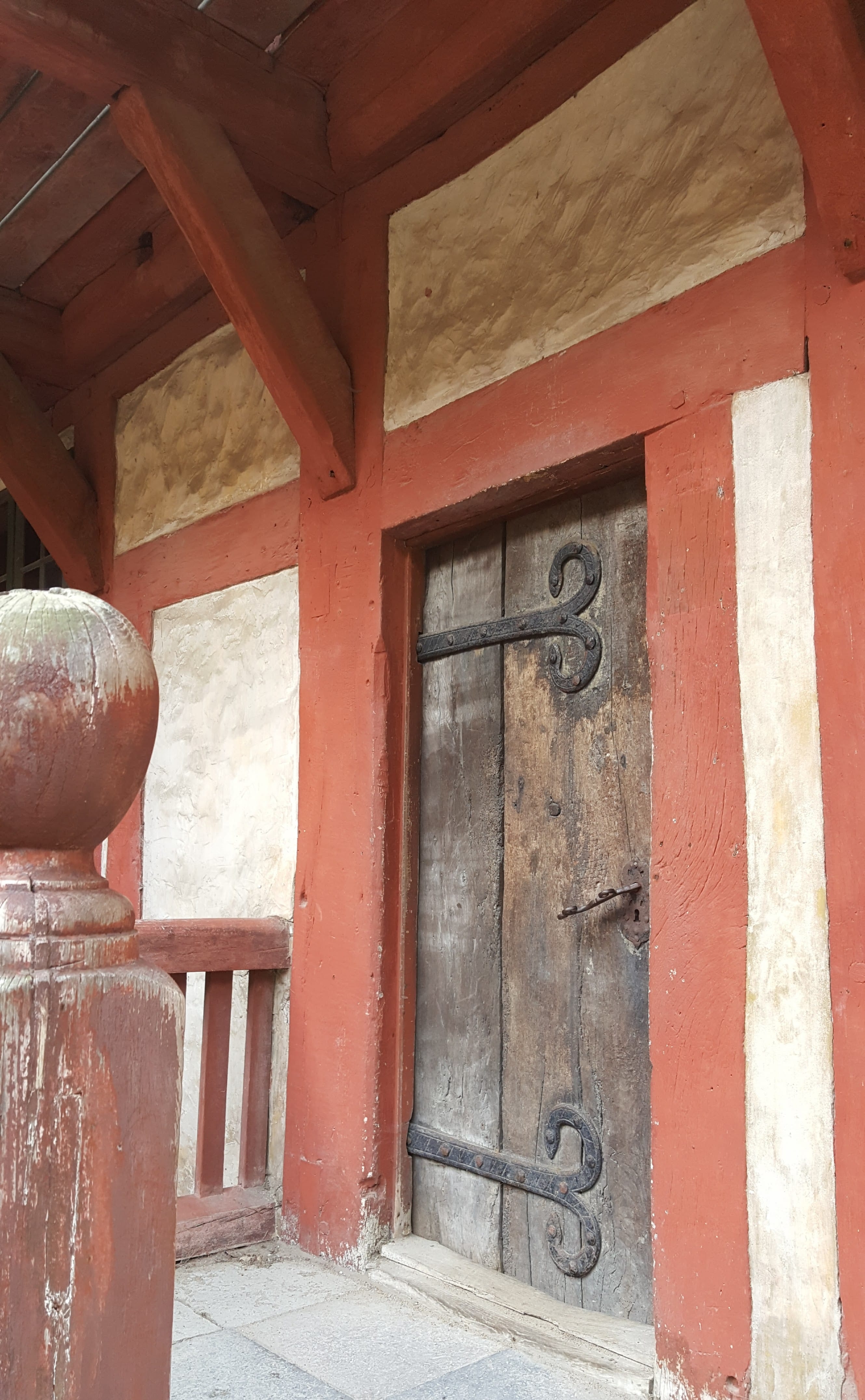
A door in the gallery of the Mayor’s House complex
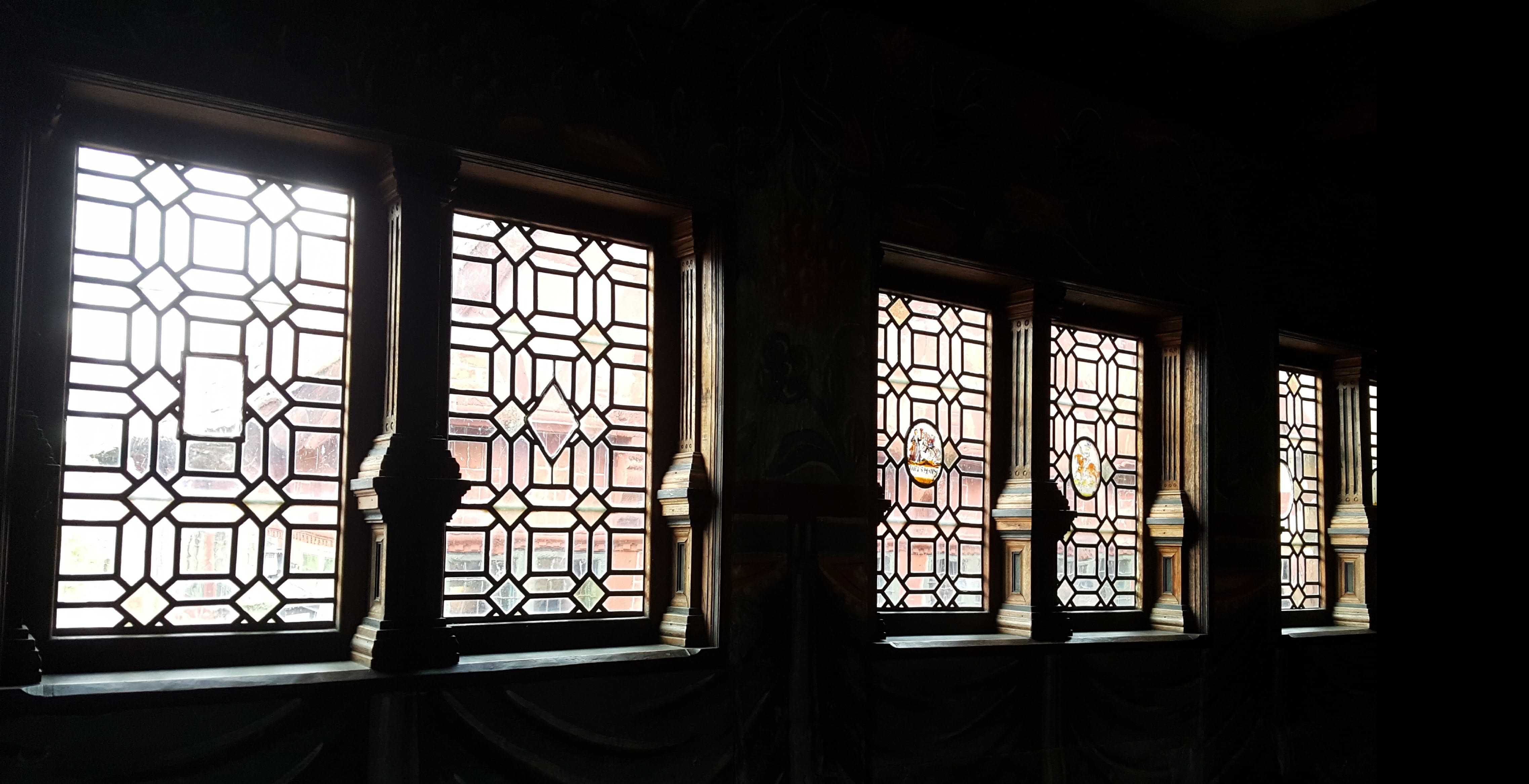
Intricate 16th-century windows in the reception hall of the Mayor’s House
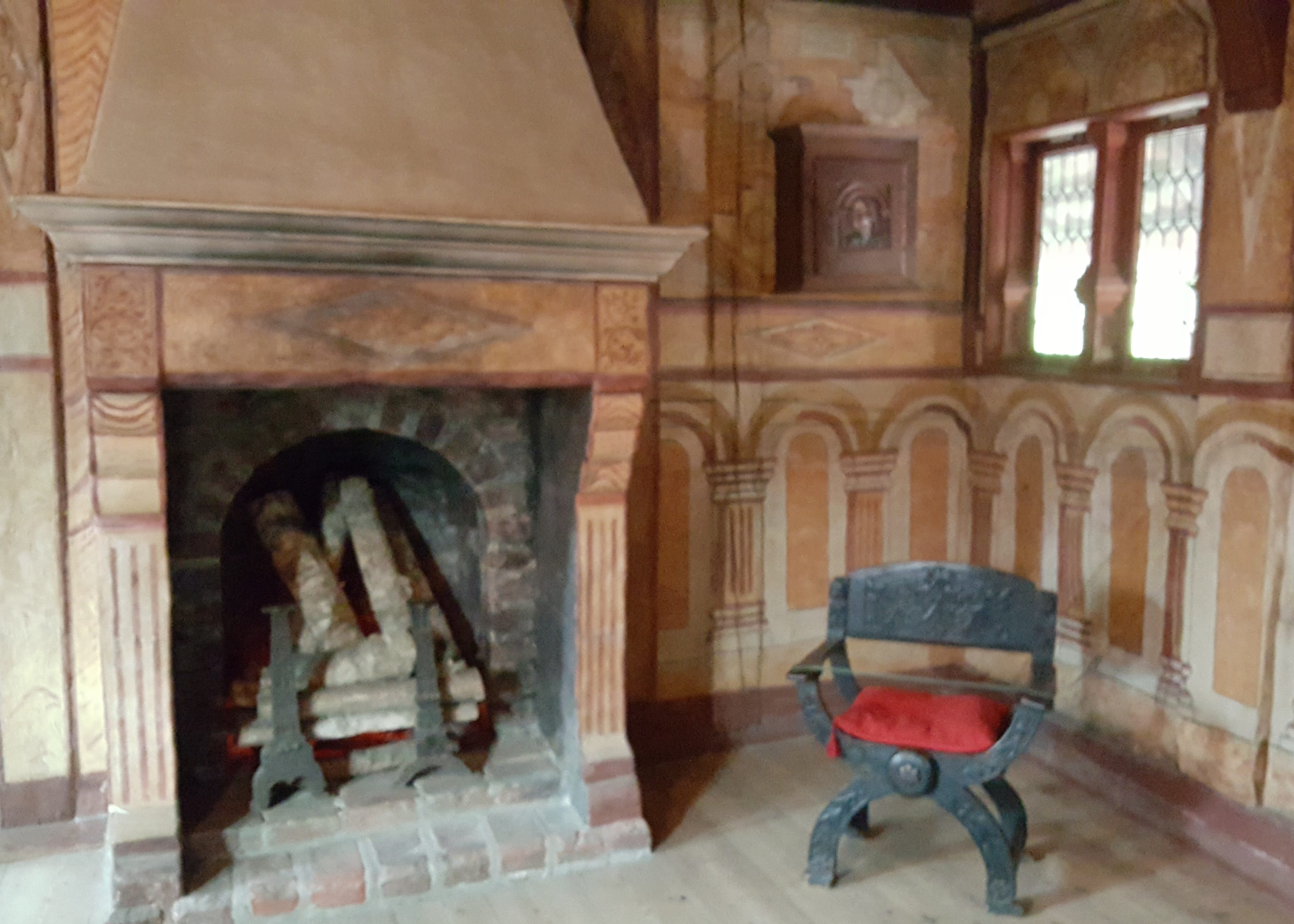
A 16th-century fireplace in the Mayor’s House
The ornate Mintmaster’s Mansion, originally built in 1683, came from Copenhagen. Its interiors show off the trompe l’oeil (fool-the-eye) skills of Baroque-era painters.
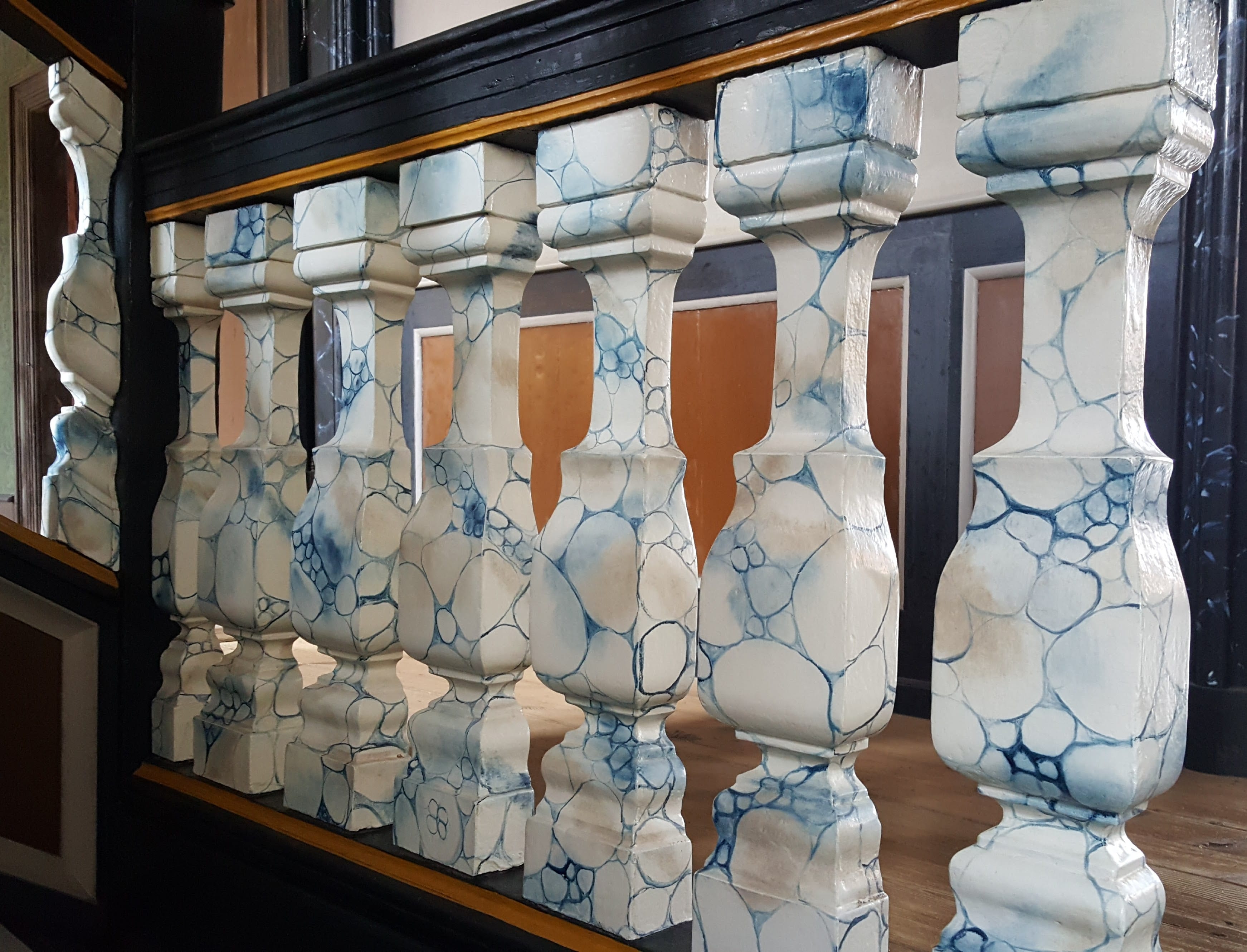
Faux marble balustrade in the Mintmaster’s Mansion
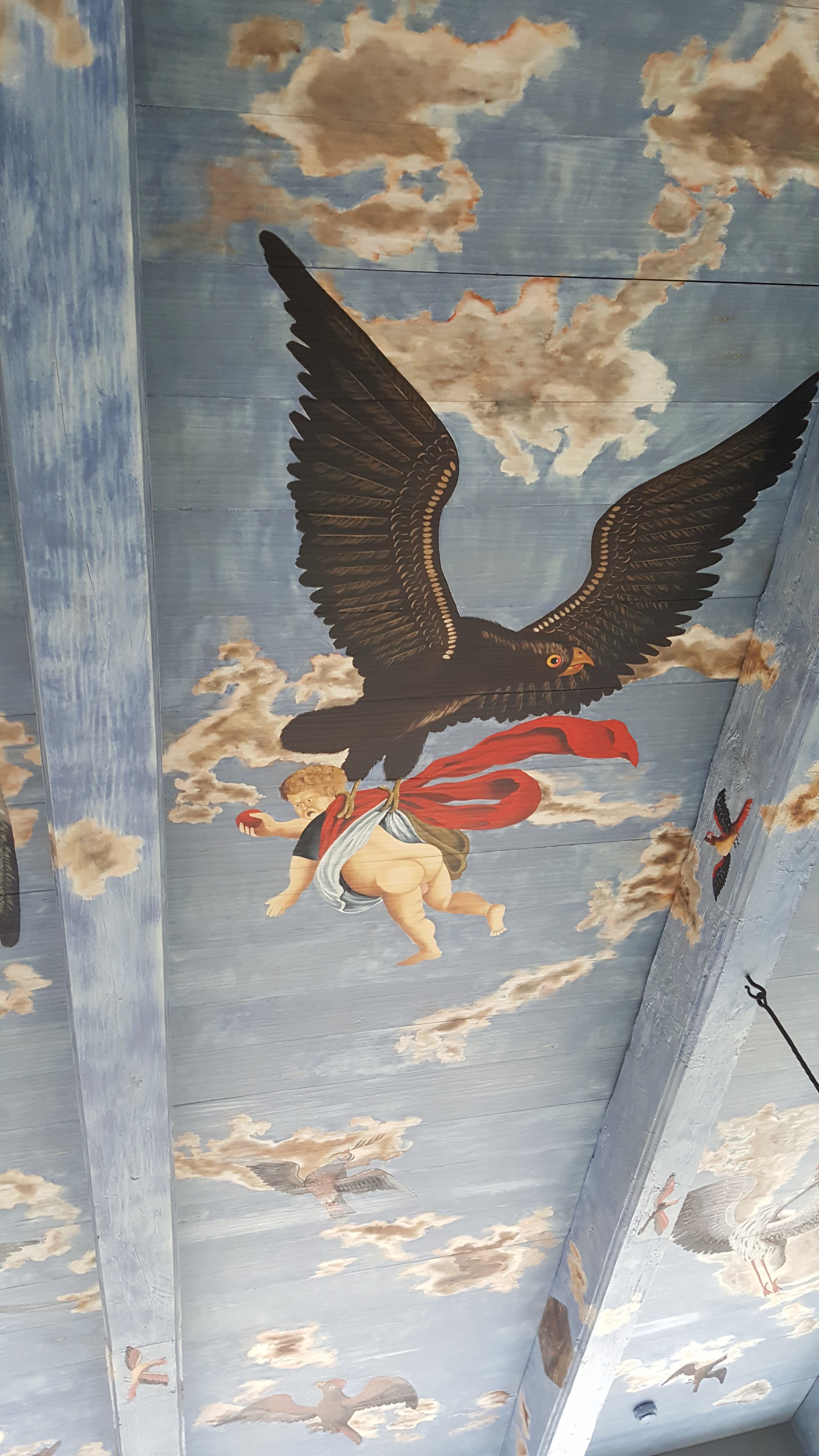
A painted ceiling in the Mintmaster’s Mansion brings the sky indoors
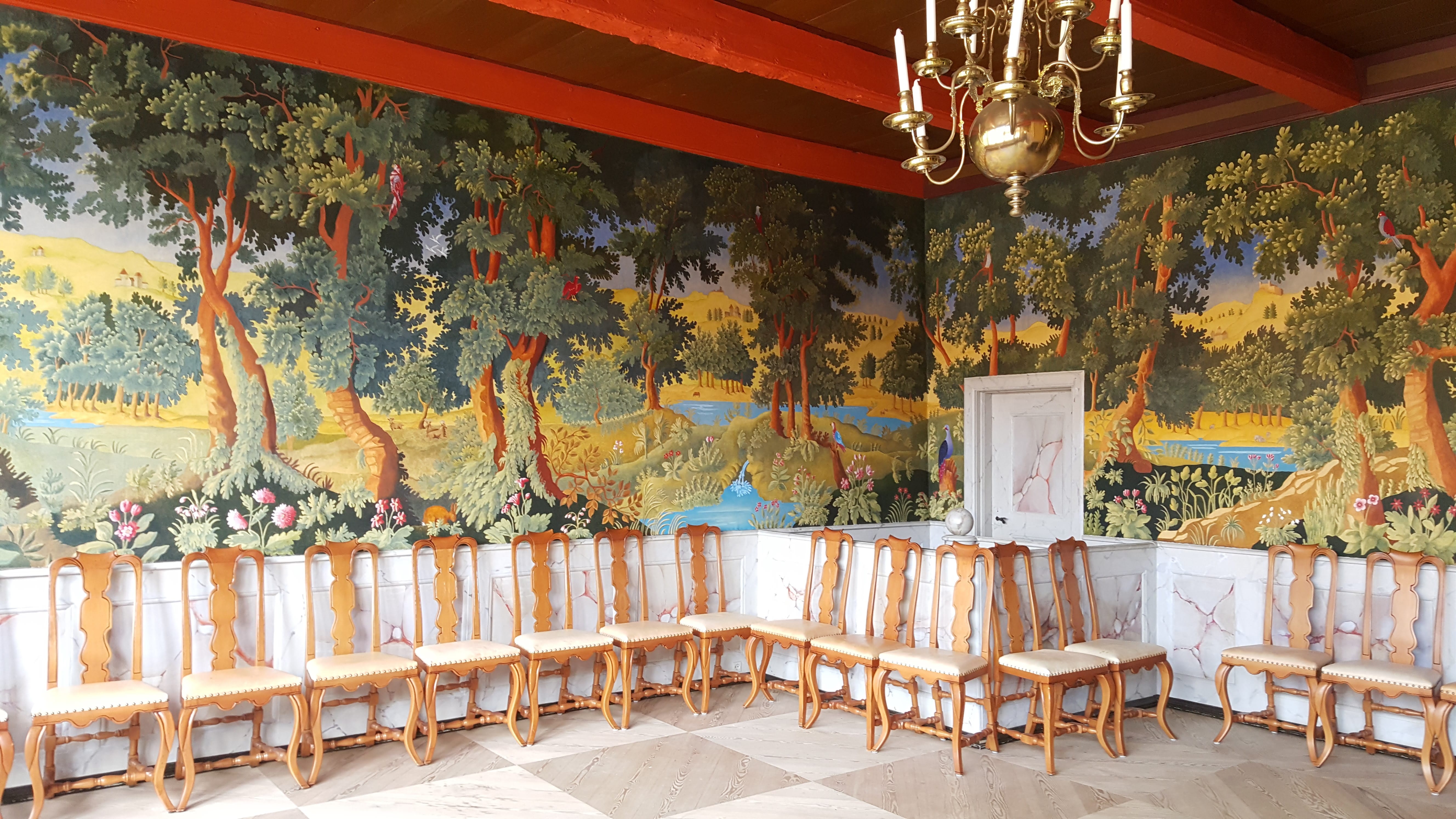
Painted faux 18th-century tapestries line a room in the Mintmaster’s Mansion
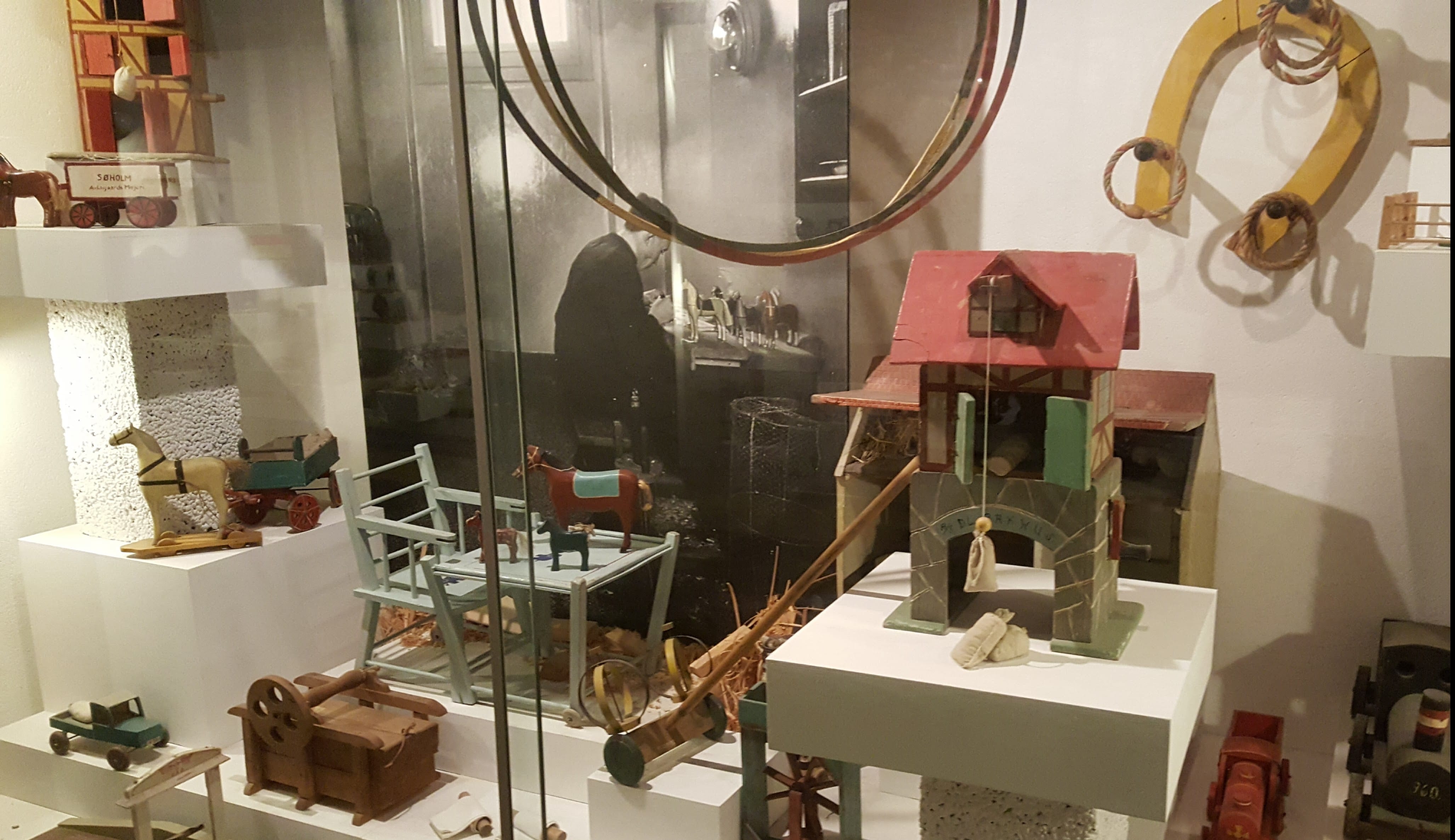
A museum display explained that during the first half of the 20th century, many Danish prisoners were kept occupied making toys. The practice was discontinued due to complaints that the prisoners were being exploited
Other relocated buildings in Den Gamle By now house specialty museums, with collections that range from antique toys, clocks, and watches to vintage posters and decorative arts.
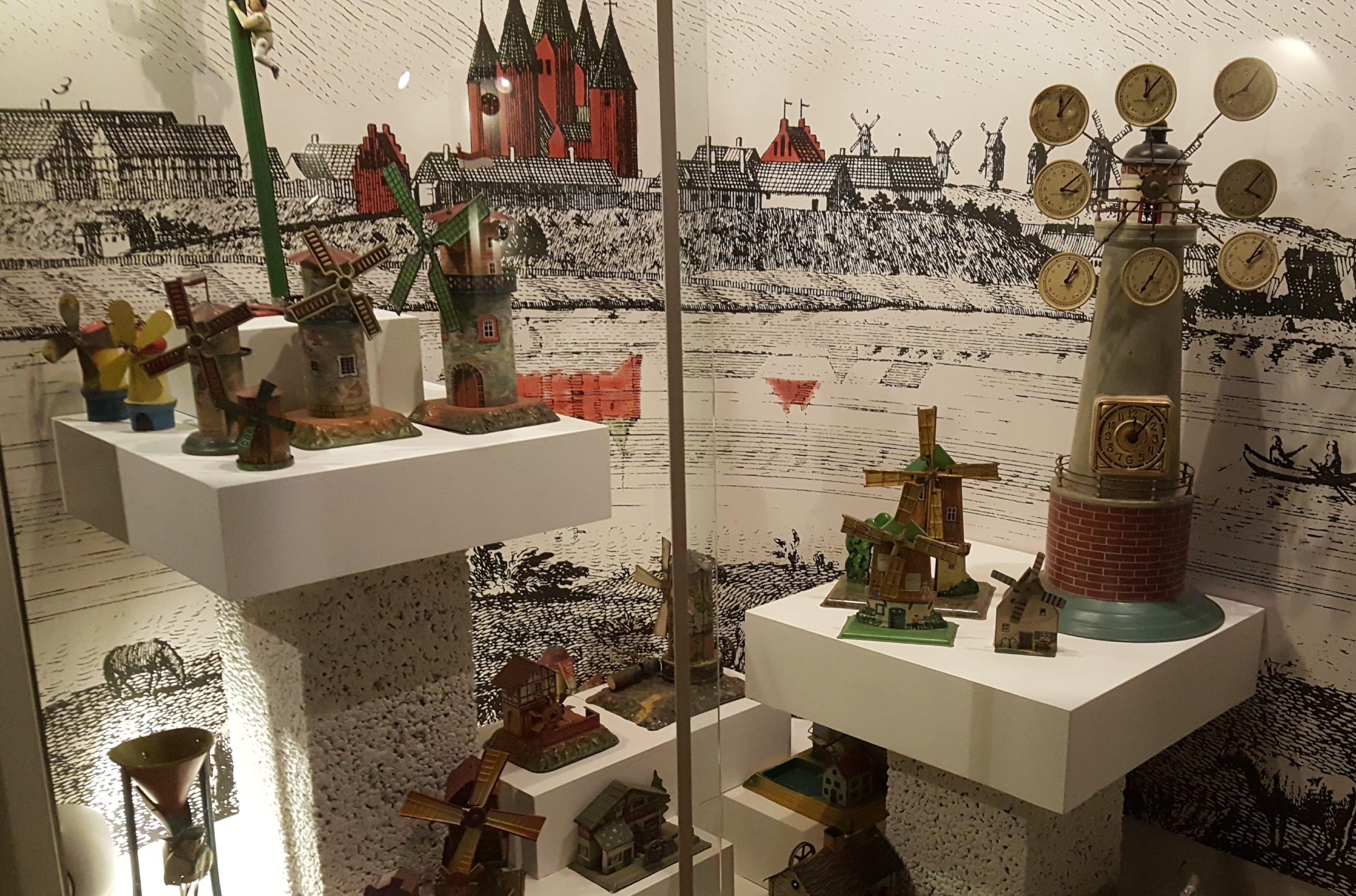
A collection of windmills in the toy museum
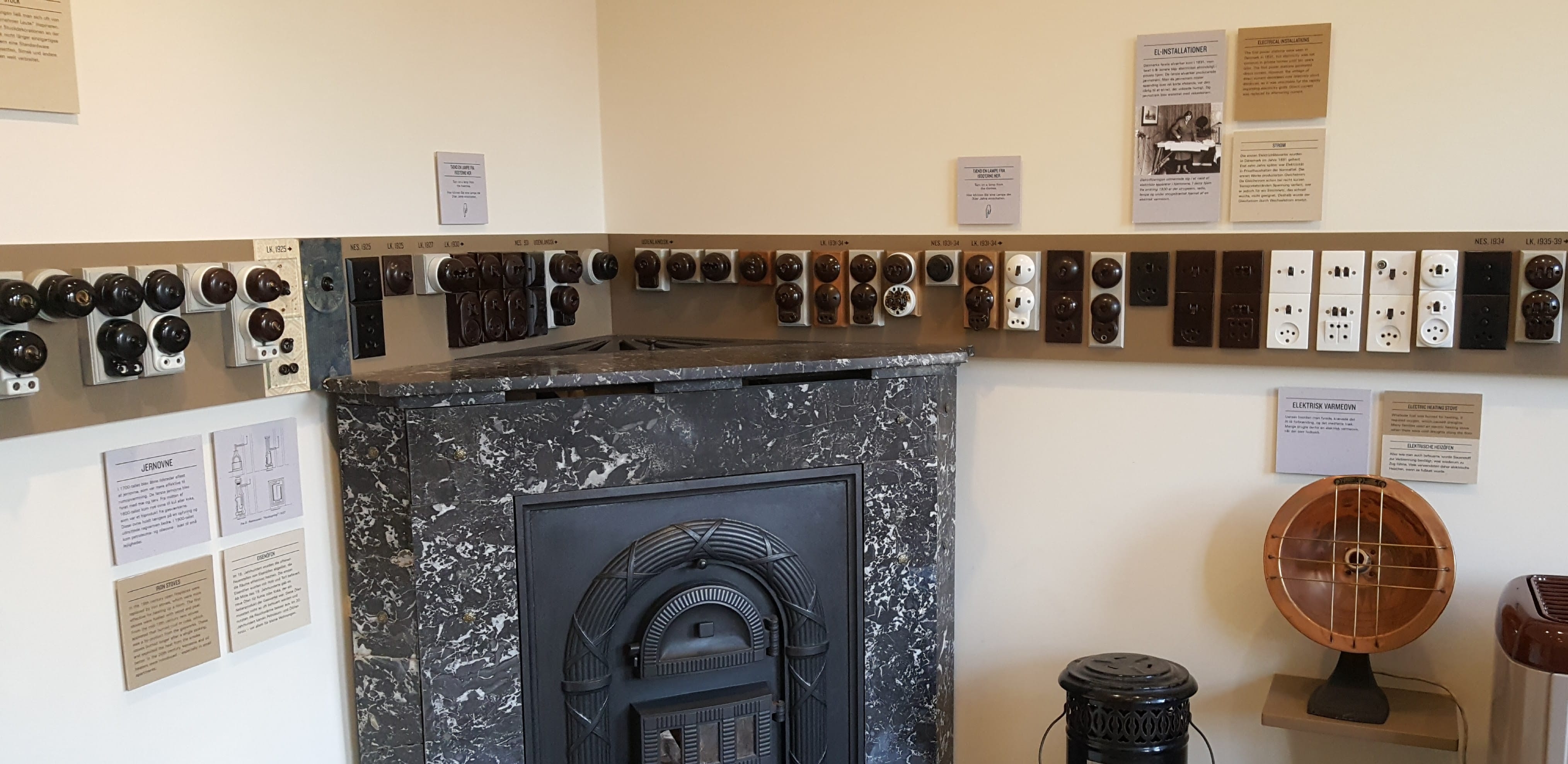
A display detailing the history of electrical hardware

Along the canal in Den Gamle By
One could easily spend all day wandering around Den Gamle By, which is still expanding. Additions are under construction for an entire block representing the 1970s. Michael had been inclined to say, “We can skip that part; we’ve already lived through it”–but then got sucked in by a “sidewalk sale” featuring cassette tape recorders, eight-track players, and other bygone stereo system components.
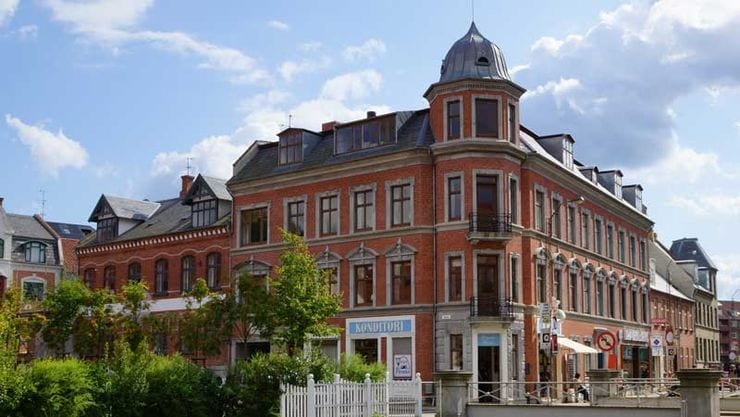
Den Gamle By’s Tårnborg neighborhood preserves the 20th century for future generations
The electronics store is located on the ground floor of an attractive corner building named Tårnborg, which was modeled after an 1898 structure in the town of Helsingør. Upstairs is the former residence of a school headmistress named Bodil Sneum. Unmarried and childless, Ms. Sneum left the entire contents of her apartment to Den Gamle By when she died in 2007 at age 96. The suite across the hall is occupied by the offices of Dr. Windfeld, who opened south Jutland’s first gynecology clinic in 1974. Behind the Tårnborg building is a re-creation of a 1970s-era urban alley, complete with a powder-blue Volkswagen Beetle and a moped-repair shop.
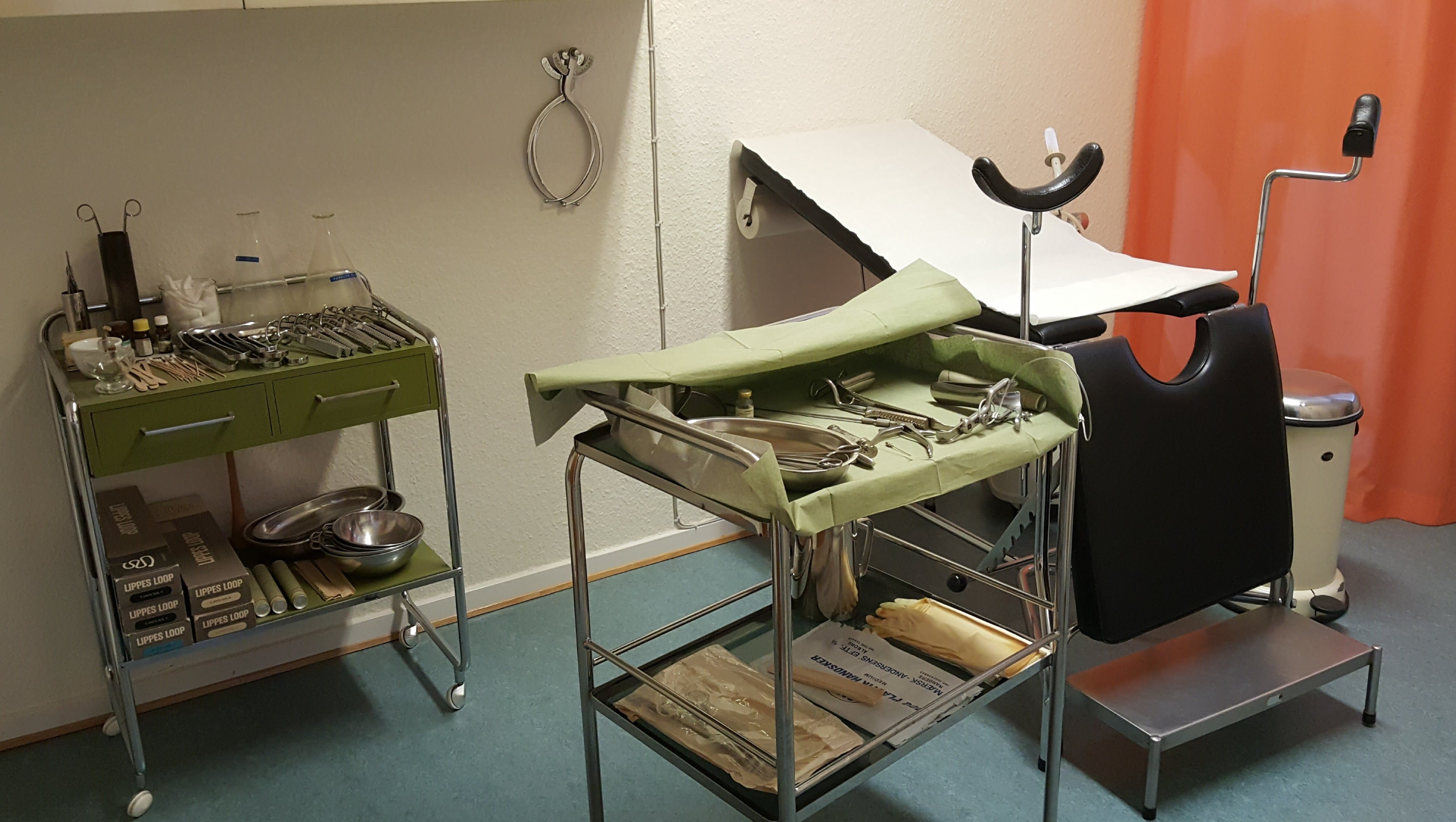
Instruments of torture in the gynecologist’s examination room, circa 1974
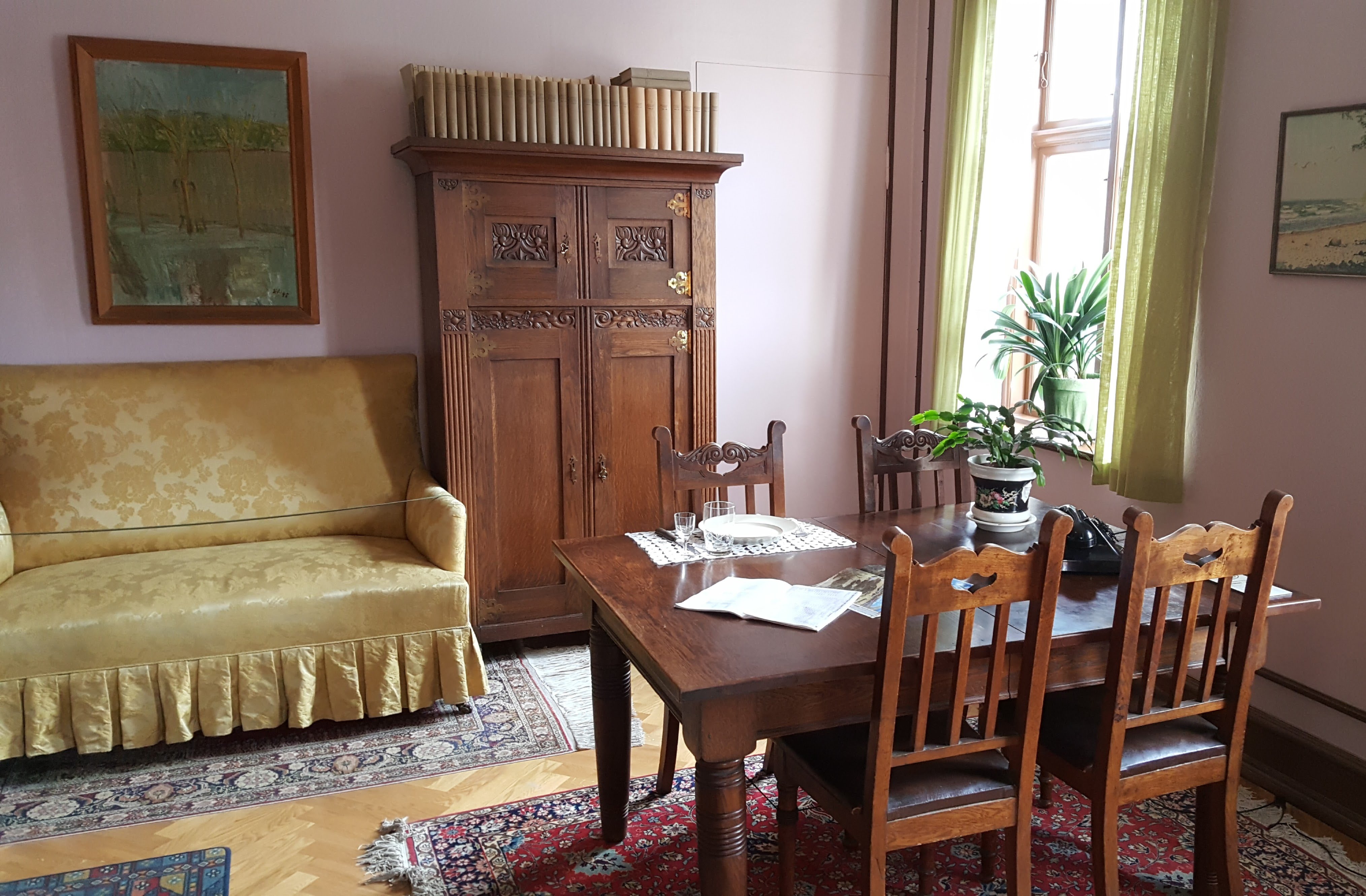
The furnishings in Bodil Sneum’s apartment reminded Nancy of her Aunt Edie’s house
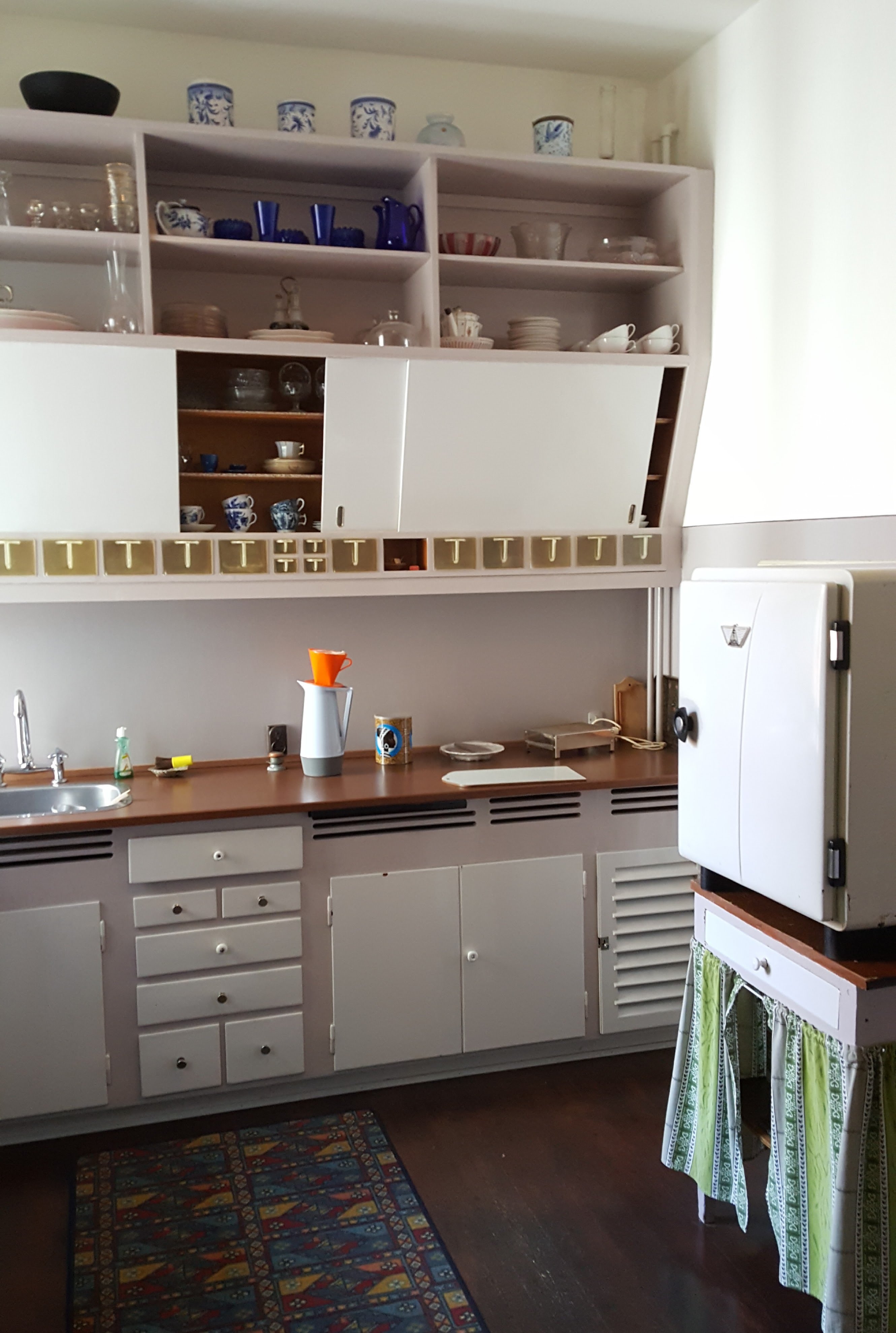
Bodil Sneum’s mid-20th century kitchen
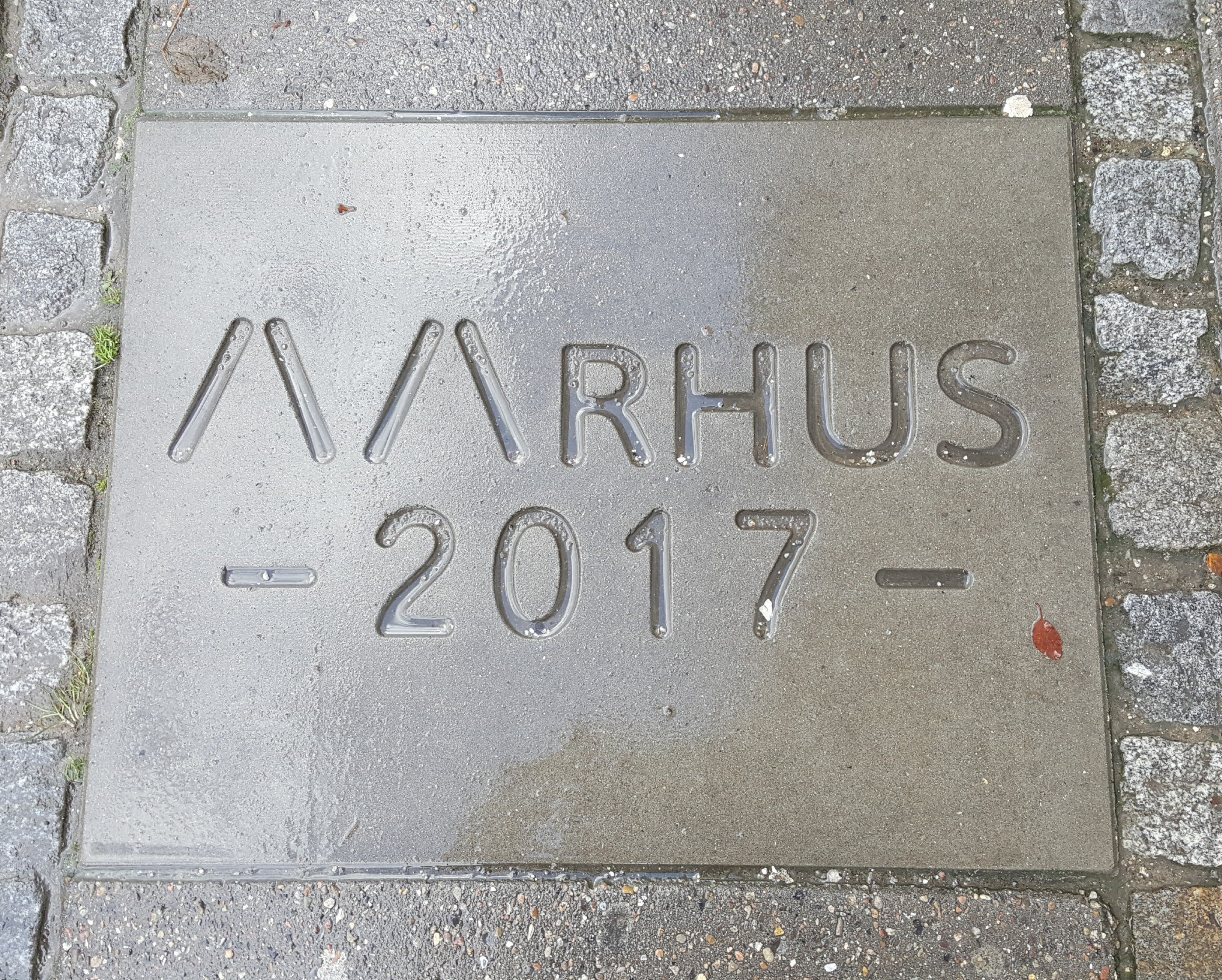
The city’s “Capital of Culture” status is set in stone on a sidewalk
Den Gamle By is only the beginning of Aarhus’s many attractions. The city has been designated as the official “European Capital of Culture” for 2017, and as such it has been the site of a number of special events all year long. We left “The Old Town” about noon–just as it was starting to rain–and hurried down the street to ARoS Kunstmuseum (art museum). After eating lunch in the cafeteria on the main floor at street level, we decided to heed advice given in the Lonely Planet Guide to Denmark and began our tour on the first level, underground. The guidebook explained that the museum is arranged like Dante’s Divine Comedy, with a set of dark, “moody” installations called 9 Spaces representing Hell on the bottom, and a heavenly halo of colored glass at the top. More down-to-Earth works are displayed on the six floors in between.
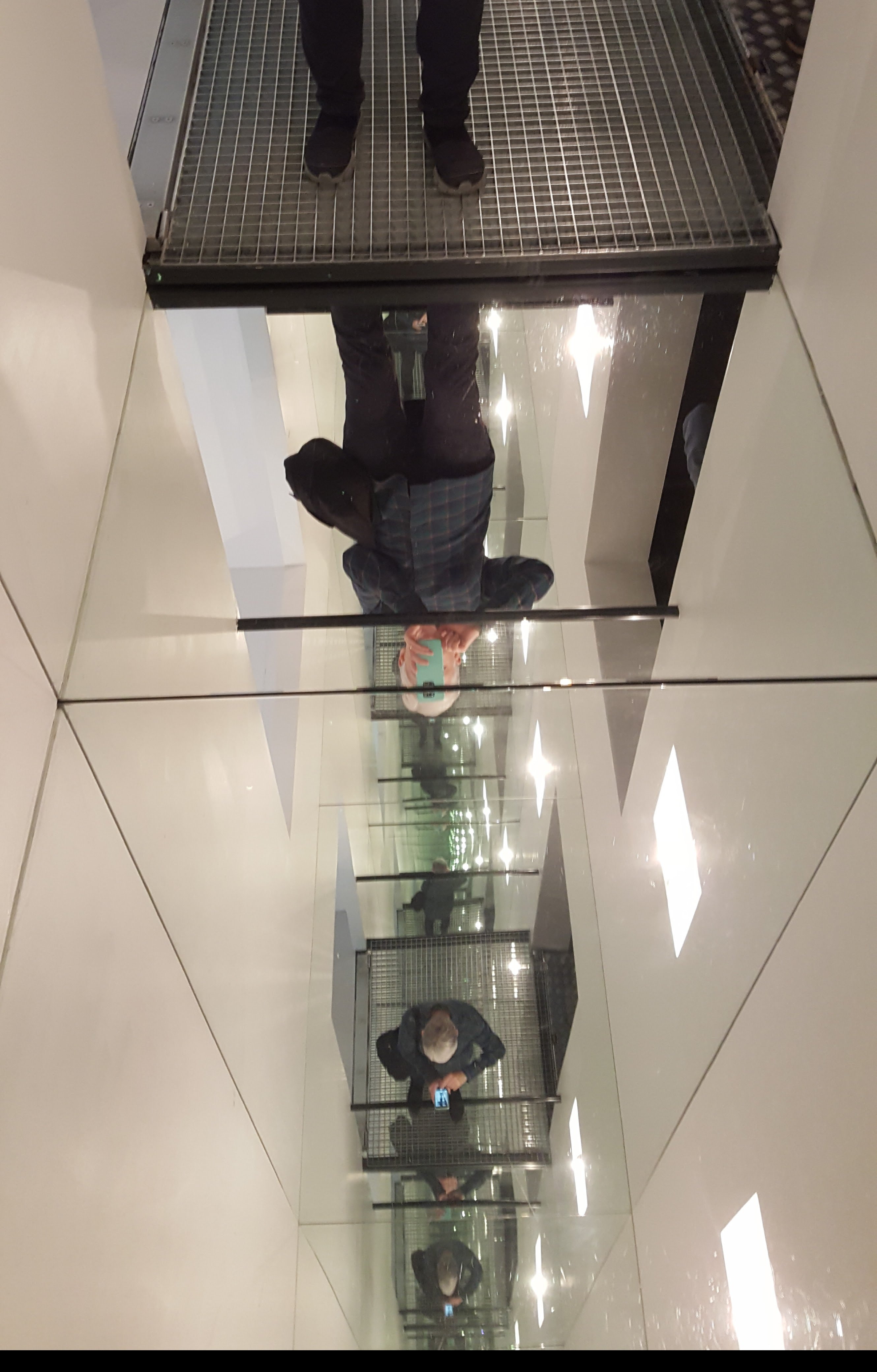
Nancy found an art installation made of mirrors very disorienting
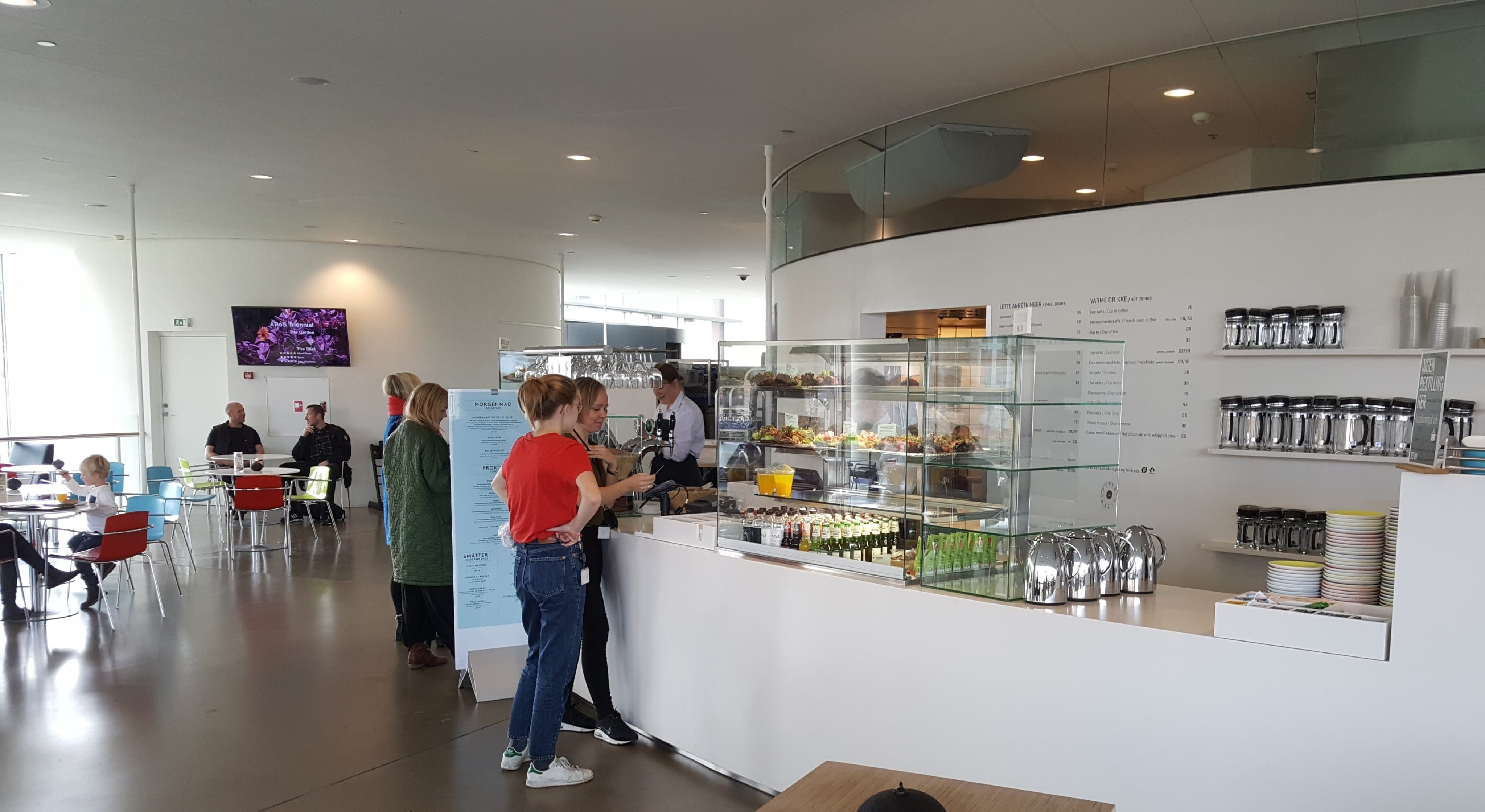
ARoS Cafeteria
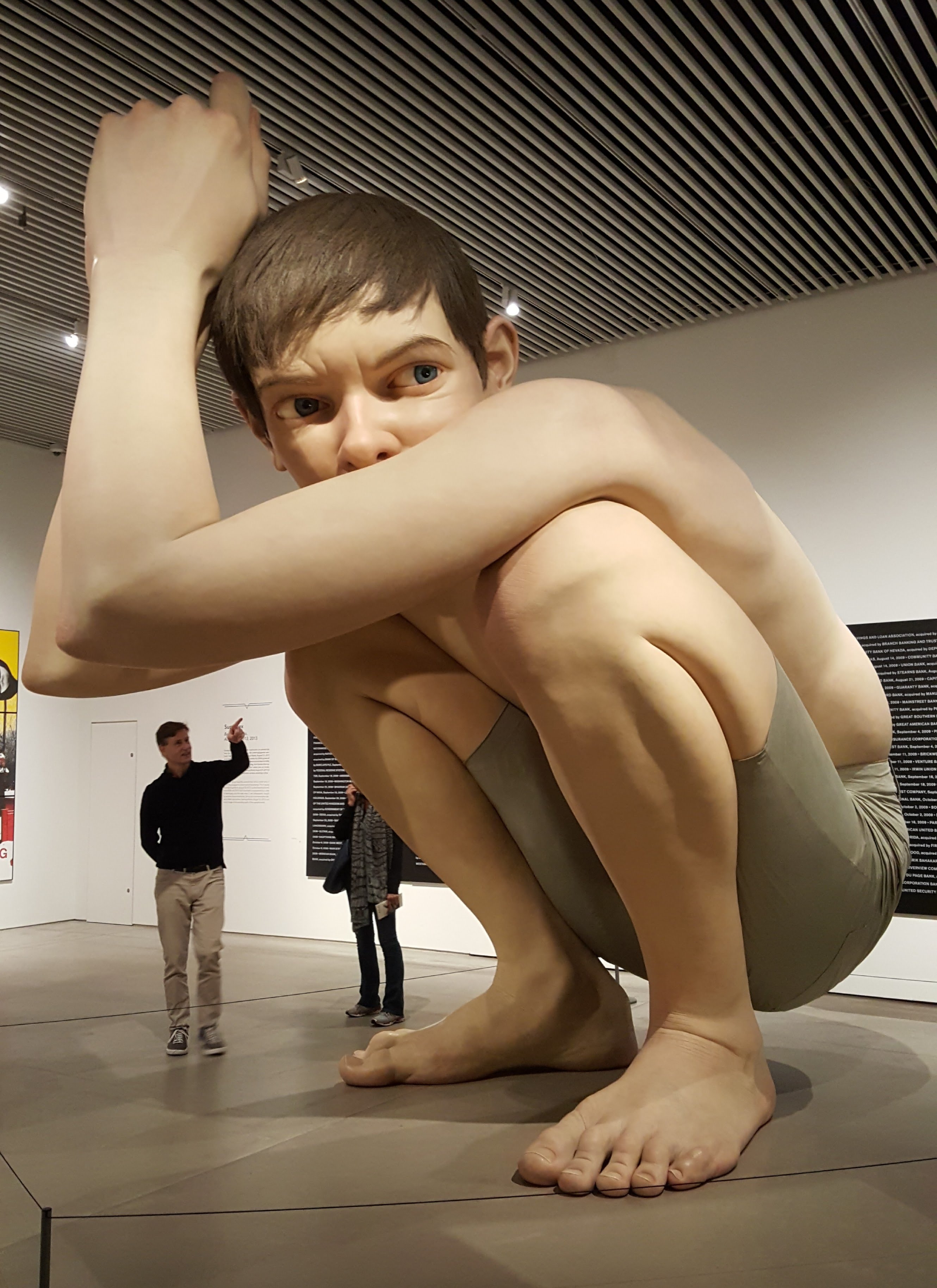
Ron Mueck’s giant “Boy” looks disconcertingly like Smeagol
One of ARoS’s special exhibitions for 2017 is a selection of works from the museum’s permanent collection called “No Man Is an Island–The Satanic Verses,” a fascinating juxtaposition of works that, in the words of the museum’s director, examines “the place of art, knowledge, and philosophical thought in a new Europe, a Europe threatened by fragmentation.” The exhibition takes its theme both from John Donne, the seventeenth-century English poet who emphasized the essential interconnectedness of individuals and society, and from contemporary novelist Salman Rushdie, who wrote that “a poet’s work is to name the unnameable, to point at frauds, to take sides, start arguments, shape the world, and stop it going to sleep.” As director Erlend G. Høyersten explains: “The freedom to speak critically … is at the core of the democratic idea. … We should never believe that the struggles that have been won in the name of freedom have been won once and for all. … They must be won over and over again. Through dialogue, critique, disagreement, and the understanding of interpersonal relations, not through demanding, but through creating and ‘stop[ping] the world going to sleep.’ This is precisely what is at stake and this is what this exhibition attempts to address.”
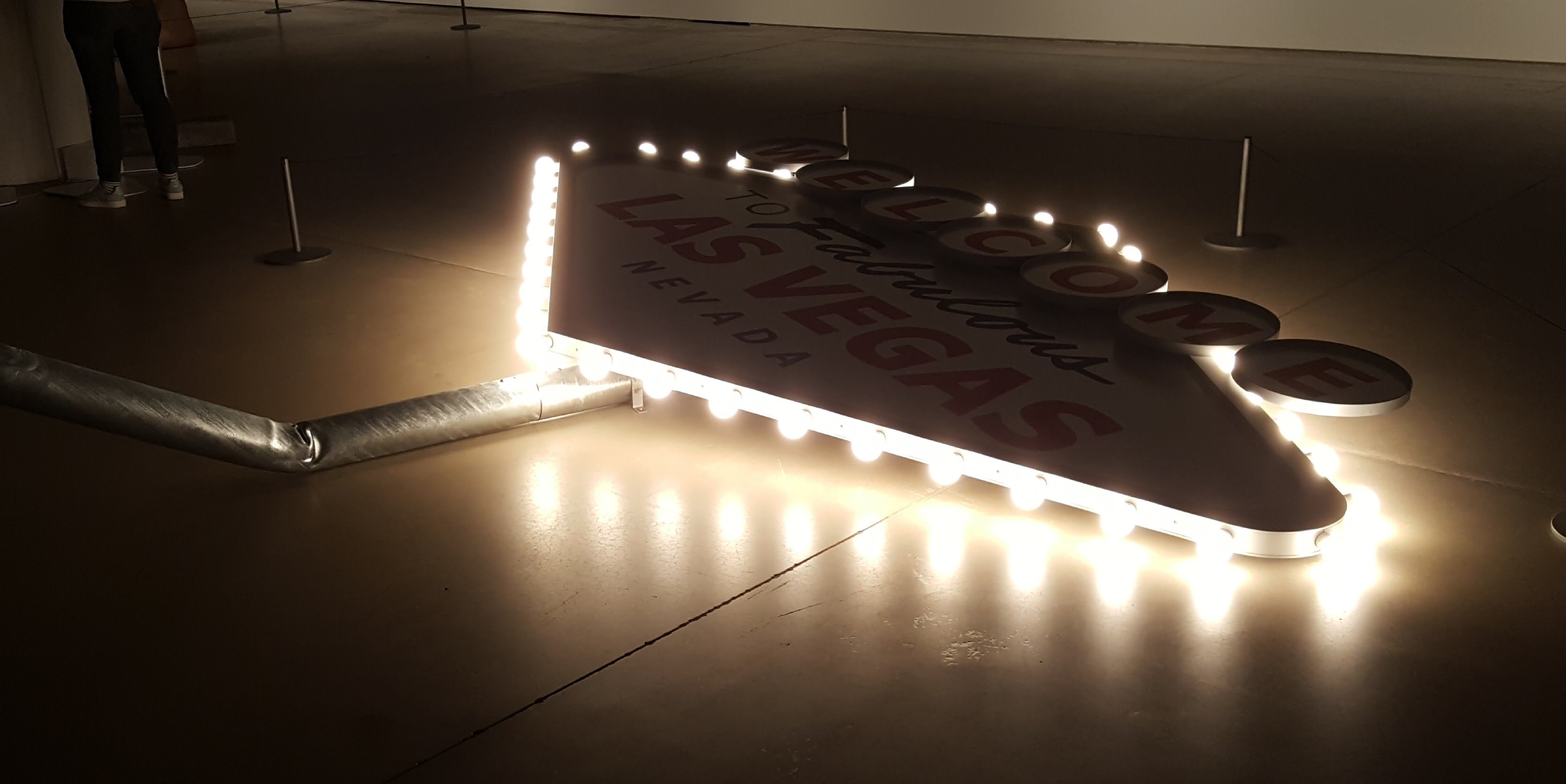
Detail of “Welcome” by Elmgreen and Dragset
Welcome depicts an Airstream trailer crushed by the famous sign that greets visitors to Las Vegas. The artists’ intent is to show the devastation that results when immigrants to a new land find that they are not received as warmly as they had supposed. The fact that we saw the artwork only two days after a gunman killed dozens of people at a Las Vegas country music festival made it all the more striking.
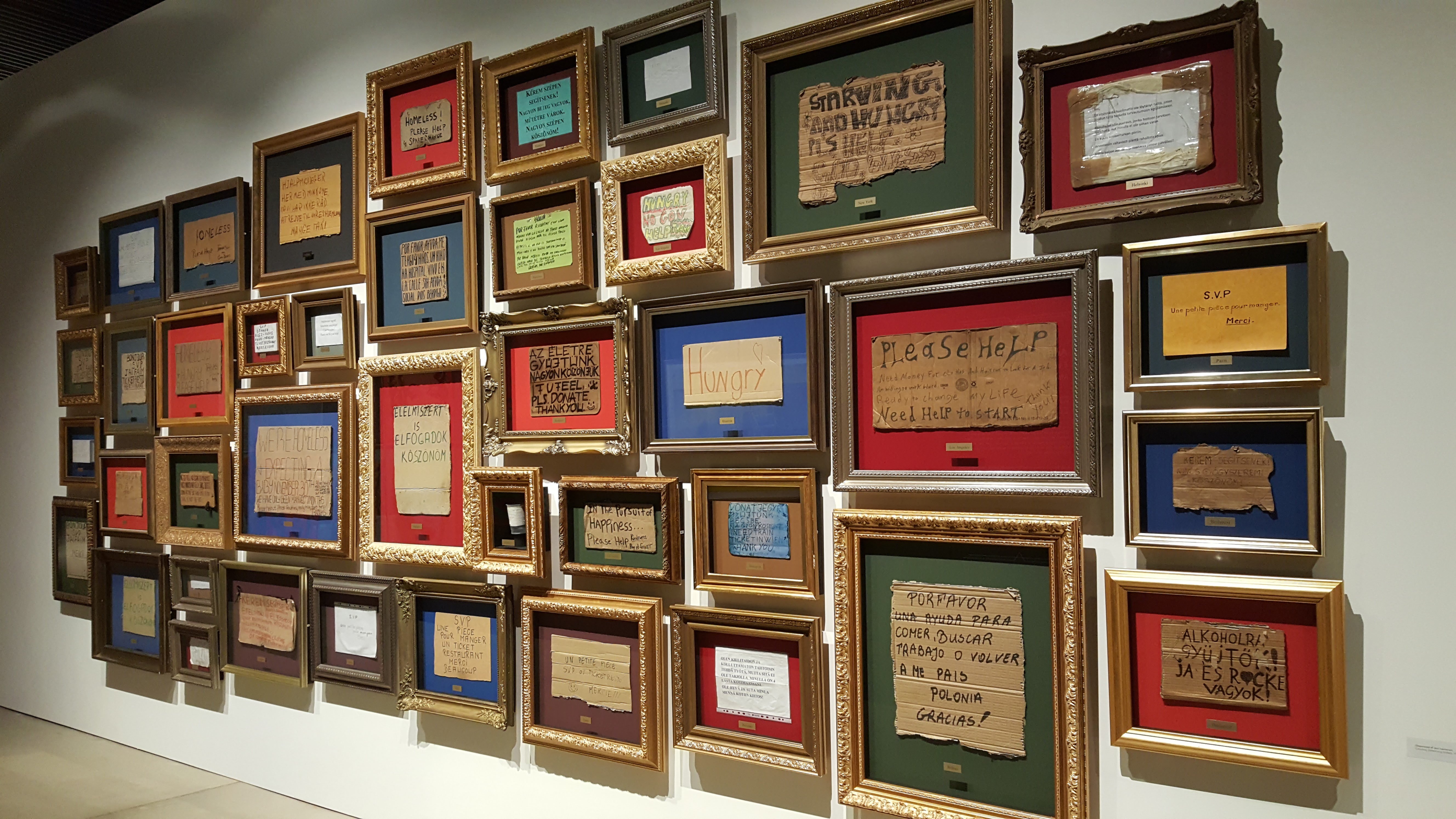
“Anything Helps” by Jani Leinonen
Anything Helps consists of cardboard signs the artist bought from street beggars in various European cities and then framed. It represents Leinonen’s criticism of “the capitalized world in which money buys everything, even the shouts of help from people in distress.” In addition, the work ironically “undermines the idea of the artist as a creative genius.”
On the next floor up, an exhibition called “The Garden” attempts to shed light on the ways humans interact with nature.
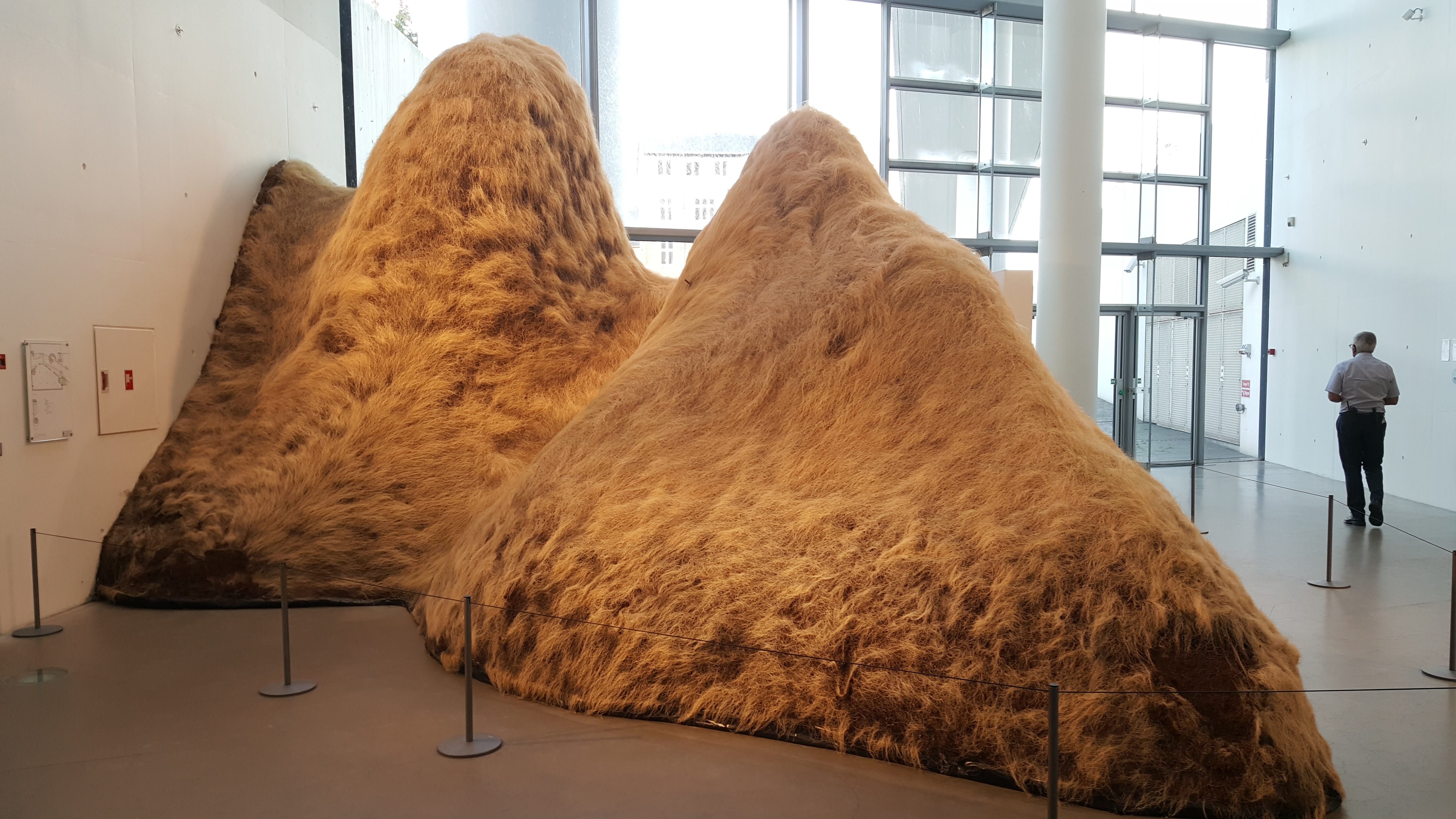
Apparently, erecting a haystack inside a museum qualifies as art
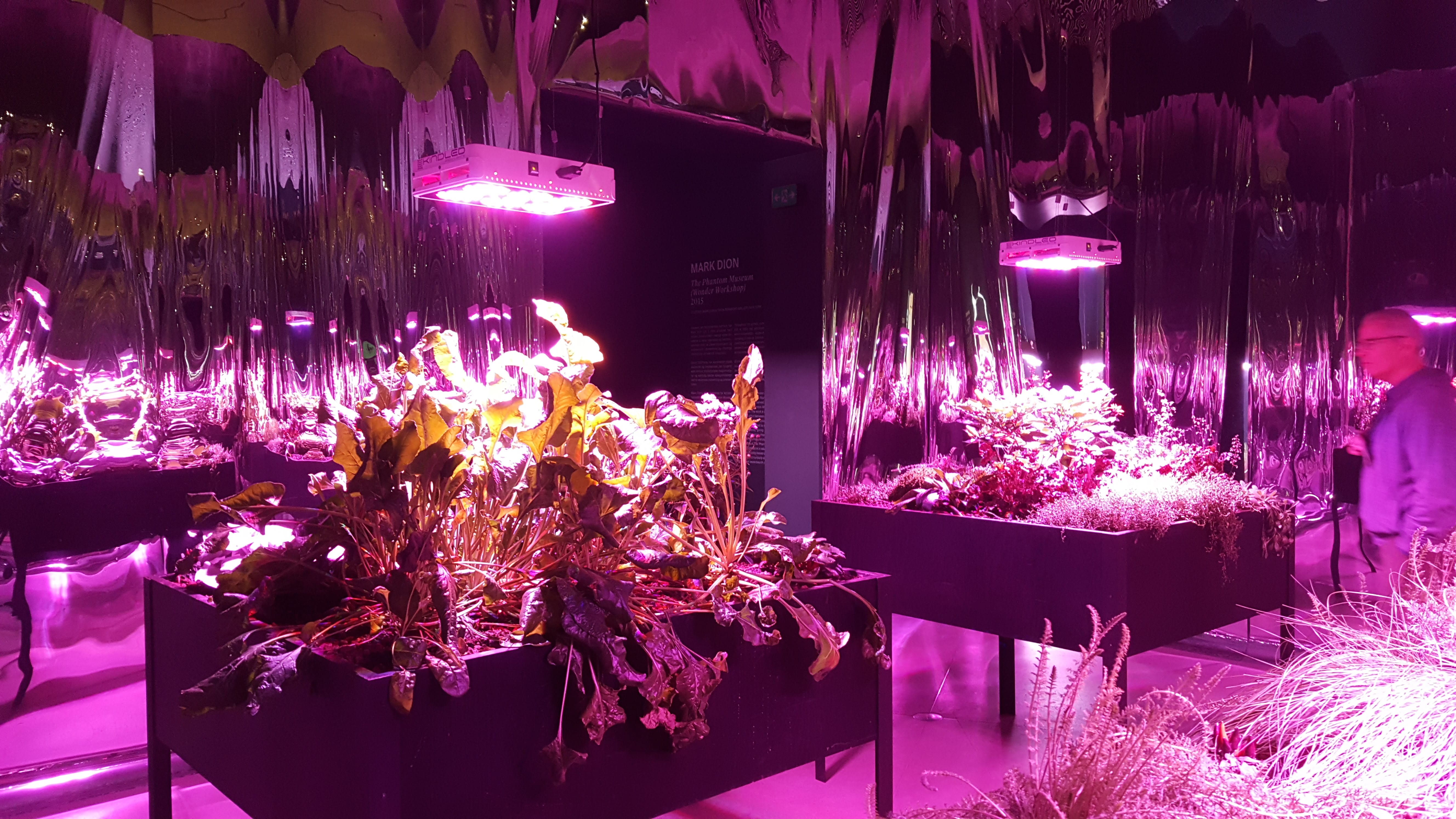
“Solar Grow Room” by Meg Webster
Included in a less provocative exhibition called “Human Nature” was a series of genre paintings done in the 1850s by Jørgen Sonne. We realized that these scenes could have been snapshots of major events in the lives of Nancy’s ancestors.
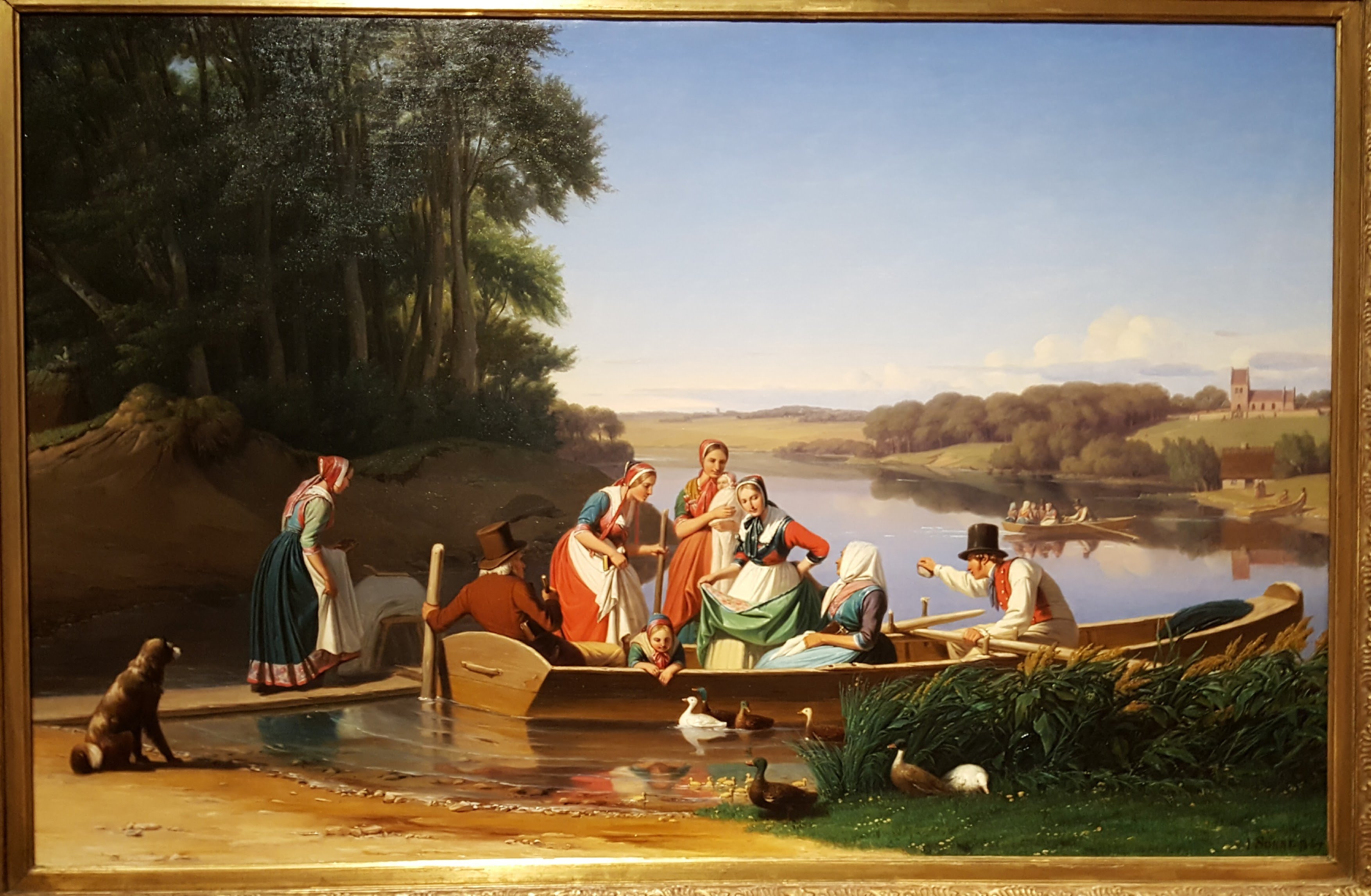
A Christening in Northern Zealand (1854) by Jørgen Sonne

A Wedding (1856). Sonne explained that the soldier at left is just discovering that his sweetheart did not wait for him to return
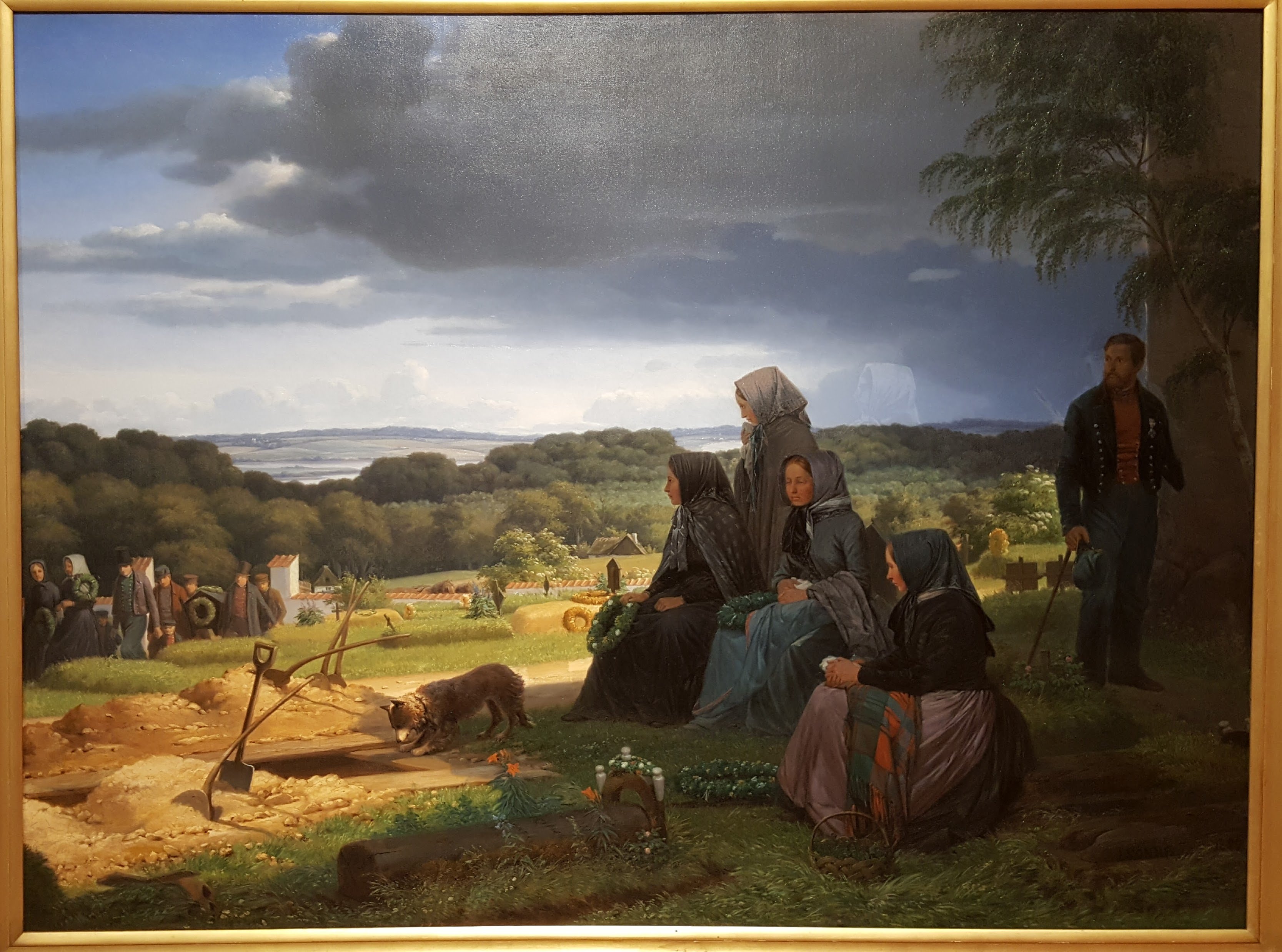
A Funeral (1859)
The museum’s topmost floor features Your Rainbow Panorama by Olafur Eliasson, a circular wall of glass through which one can view all of Aarhus through gradually changing hues. Today’s rain grayed the effect somewhat, but it was still delightful.
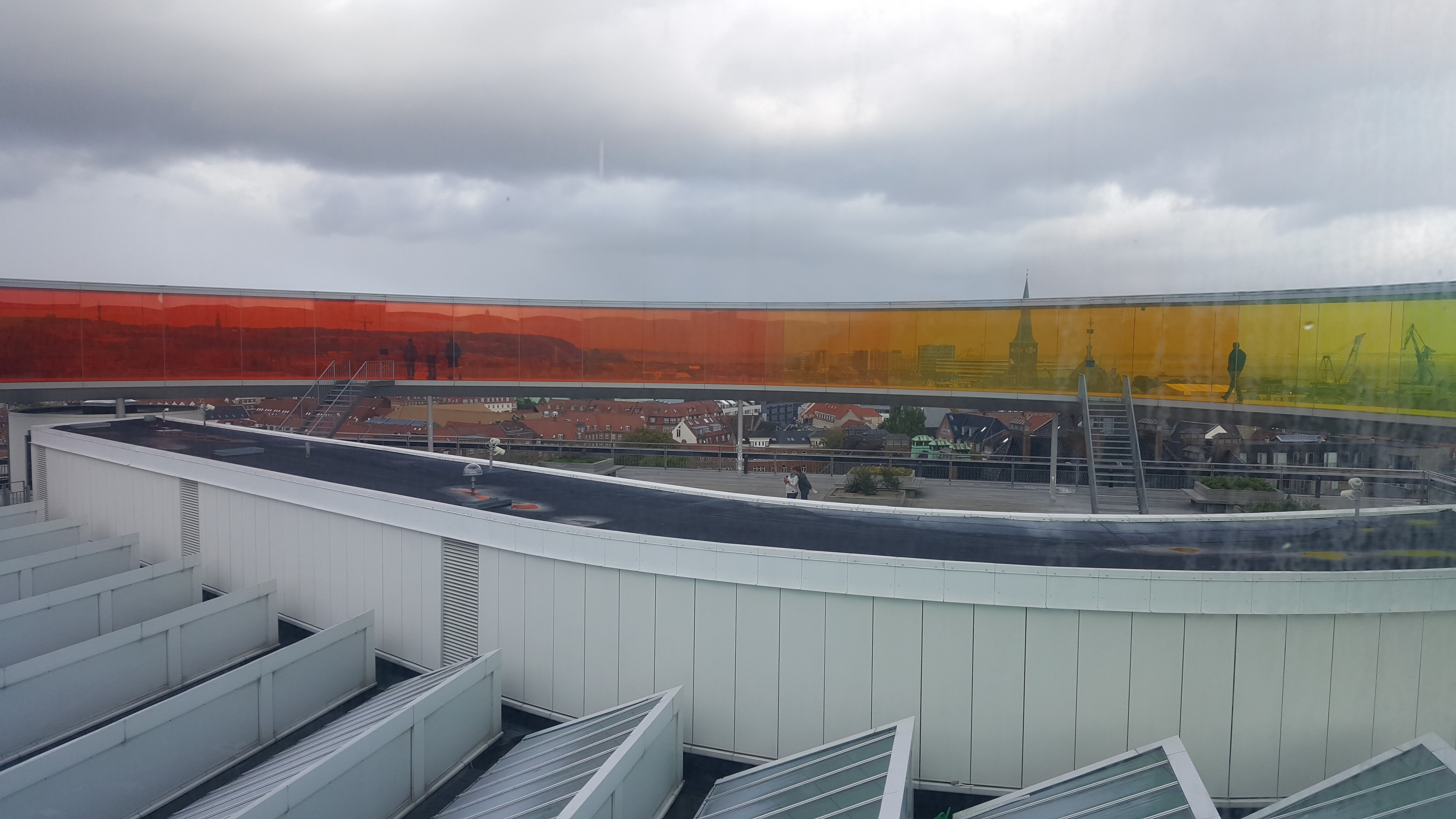
“Your Rainbow Panorama”

An unfiltered view of Aarhus from the roof of the ARoS Kunstmuseum
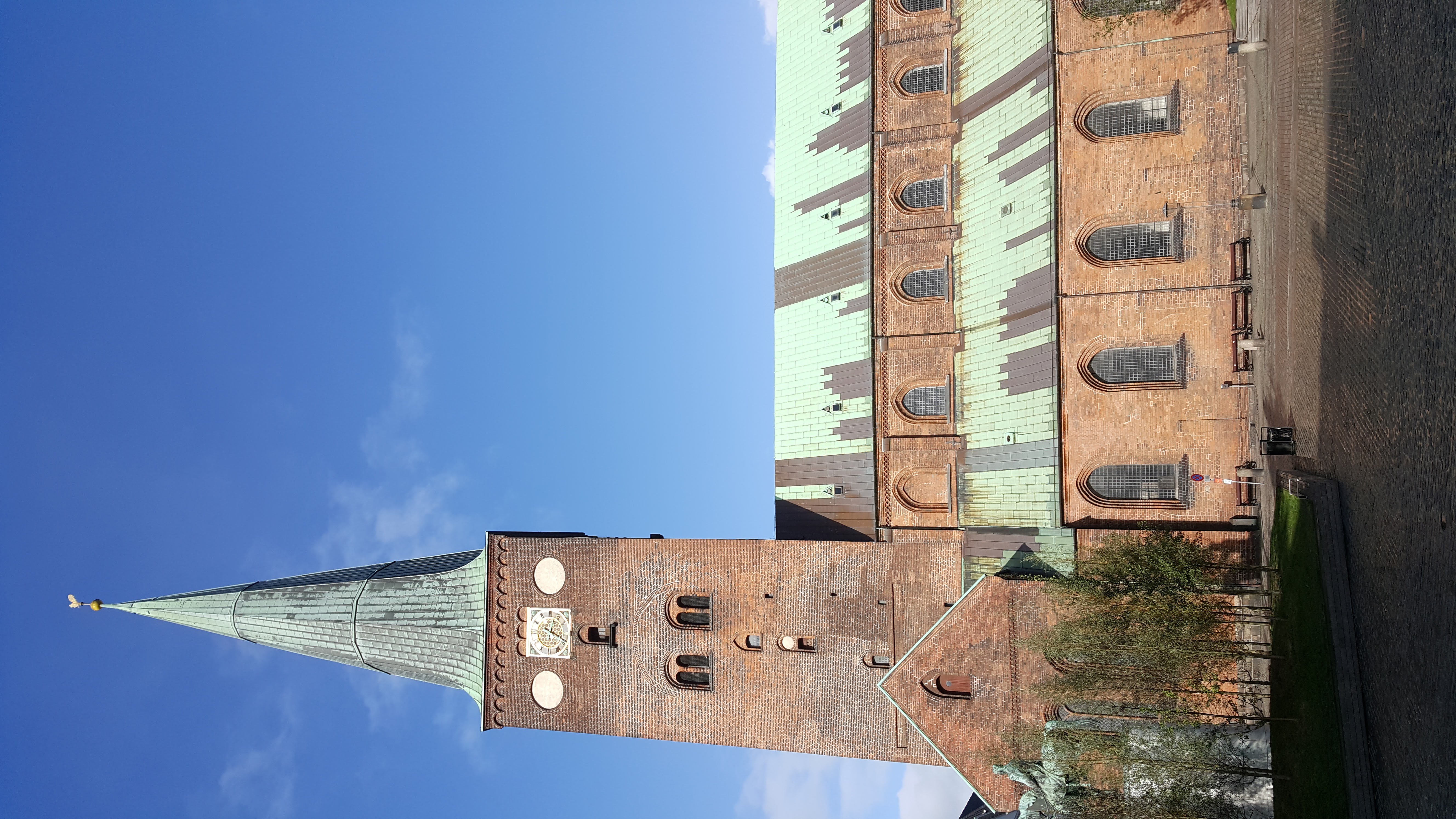
Aarhus Domkirke
Before we left Aarhus, we made a brief stop at the Domkirke (cathedral), which Garry Keyes had recommended to us. Unfortunately, the church had closed half an hour before we arrived, so we didn’t get to see the “suspended organ” Garry had described, but our drive through the city to get there was interesting. Michael was intrigued by the number of bicycles parked outside tall office buildings, while Nancy was taken by the number of baby buggies–as opposed to strollers–that parents were pushing around the streets.
Another church–this one in Stilling Parish, about 20 km from Aarhus–was likewise locked, but the drive from there through the charming town of Skanderborg and around Skanderborgsø (sø = lake) made the trip worthwhile.
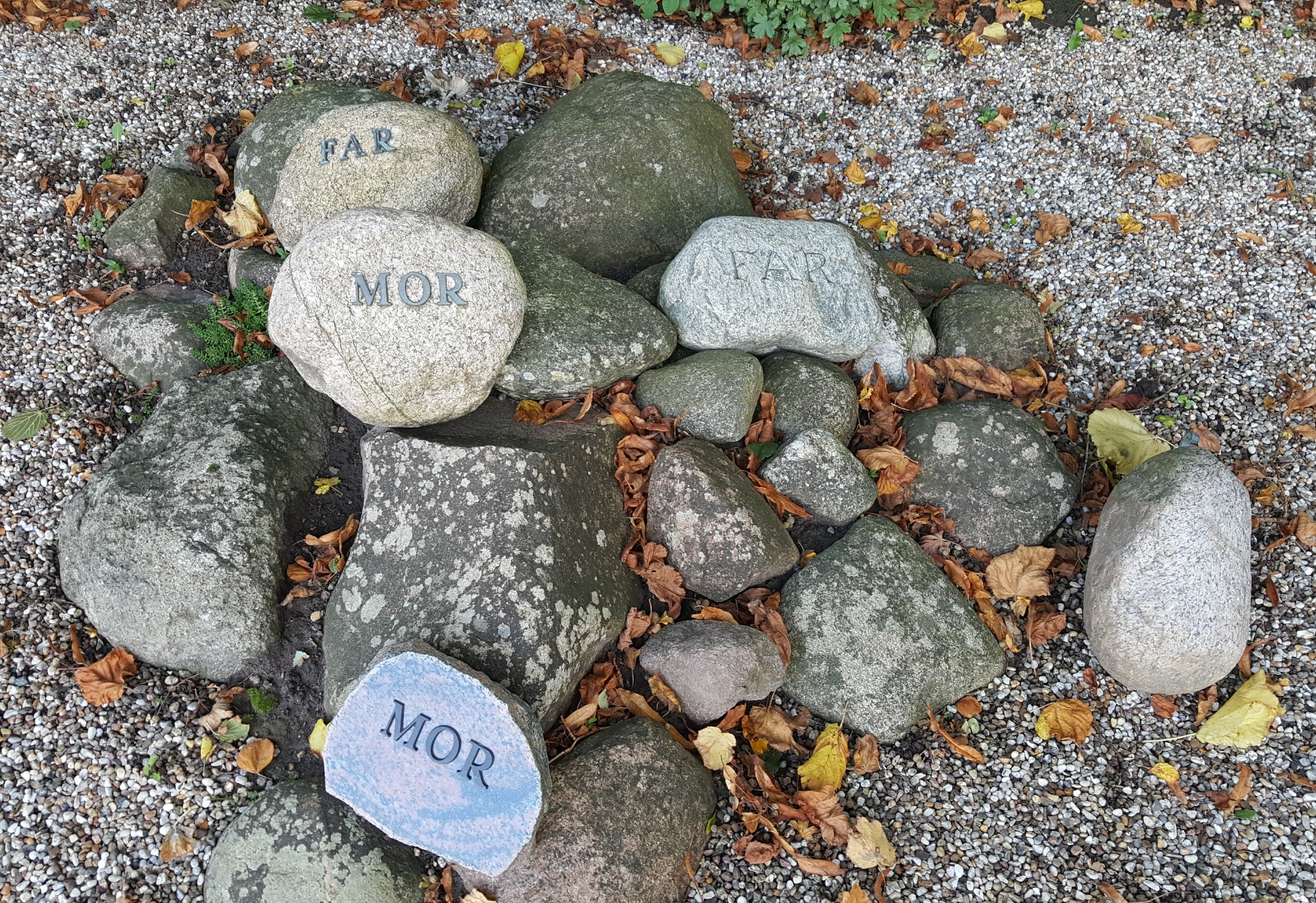
Stones in memory of several mothers and fathers, now relegated to the discard pile. (As Donald Trump might tweet: Sad!)
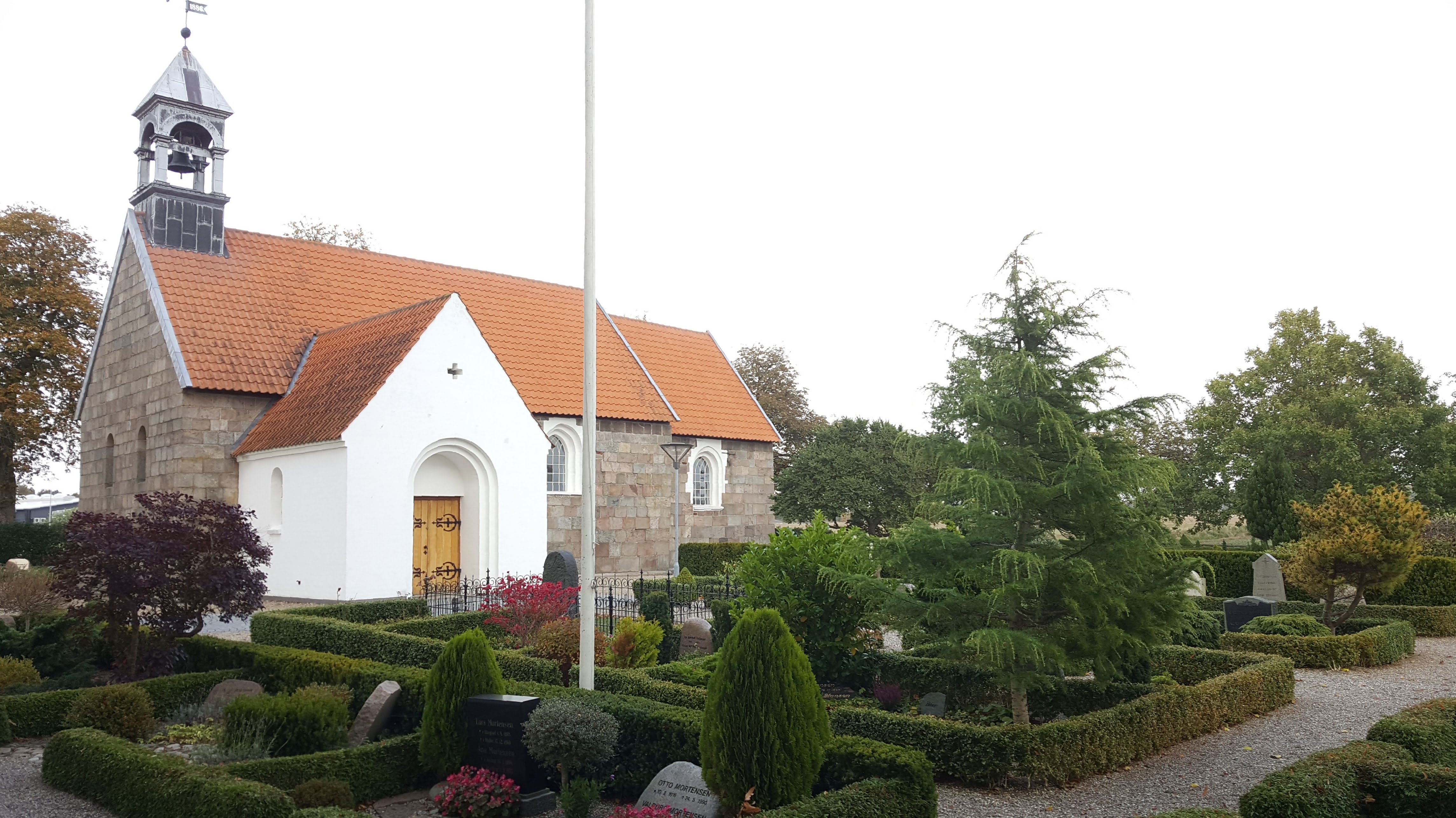
Stilling Kirke, the christening and burial place of a few of Nancy’s great-grandfather’s 18th-century forebears
Our plan for the remaining daylight hours was to enjoy more of the scenic drive through Denmark’s Søhøjlandet (lake highlands) toward Ry, our destination for the evening. Although the weather wasn’t perfect, it did provide dramatic lighting over Mossø (Moss Lake) and the moors and cultivated fields around it. Despite the fact that this picturesque region is only forty-five minutes from bustling Aarhus, the Danes have resisted the temptation to overdevelop it.
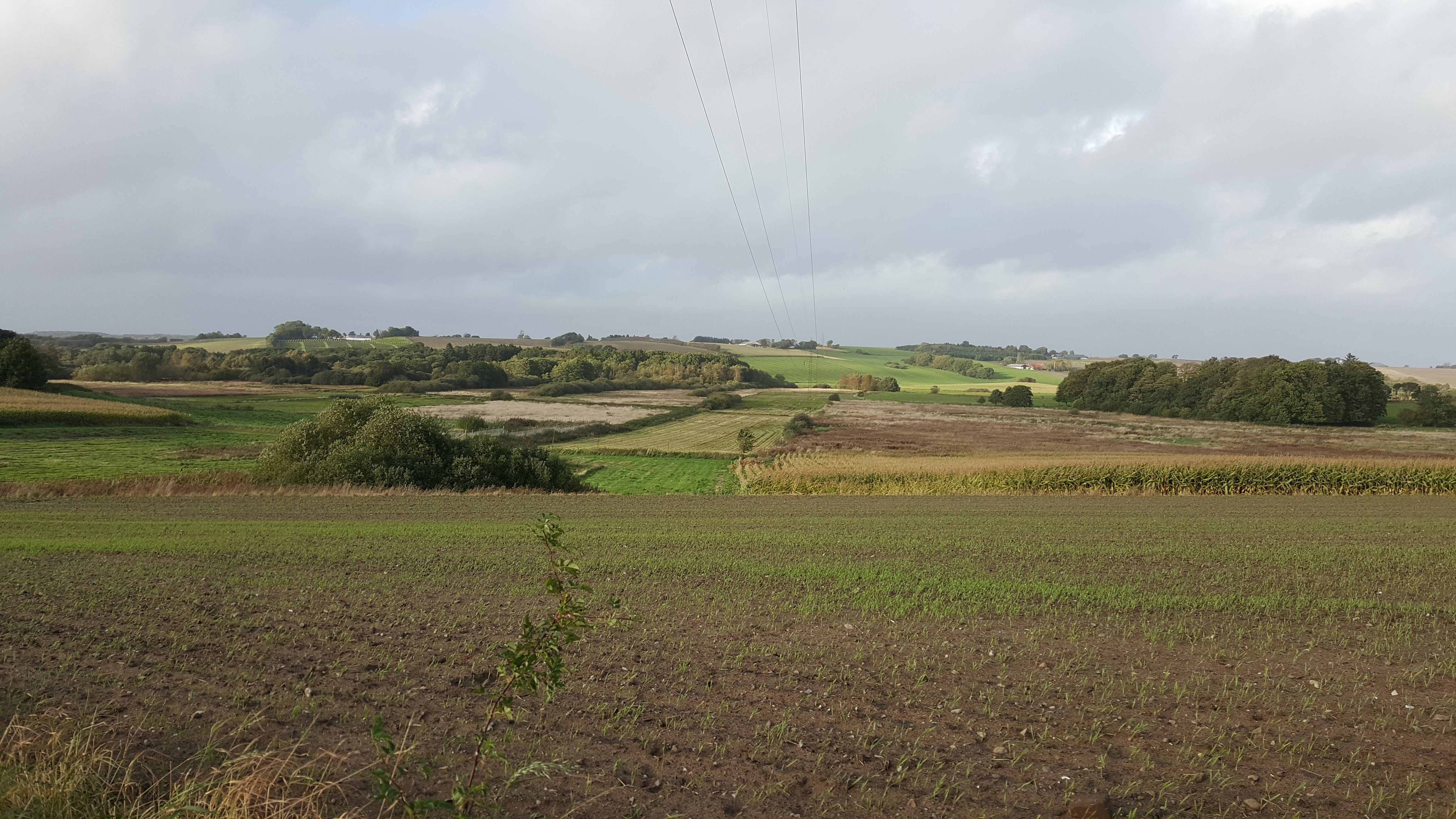
Tilled fields outside Skanderborg
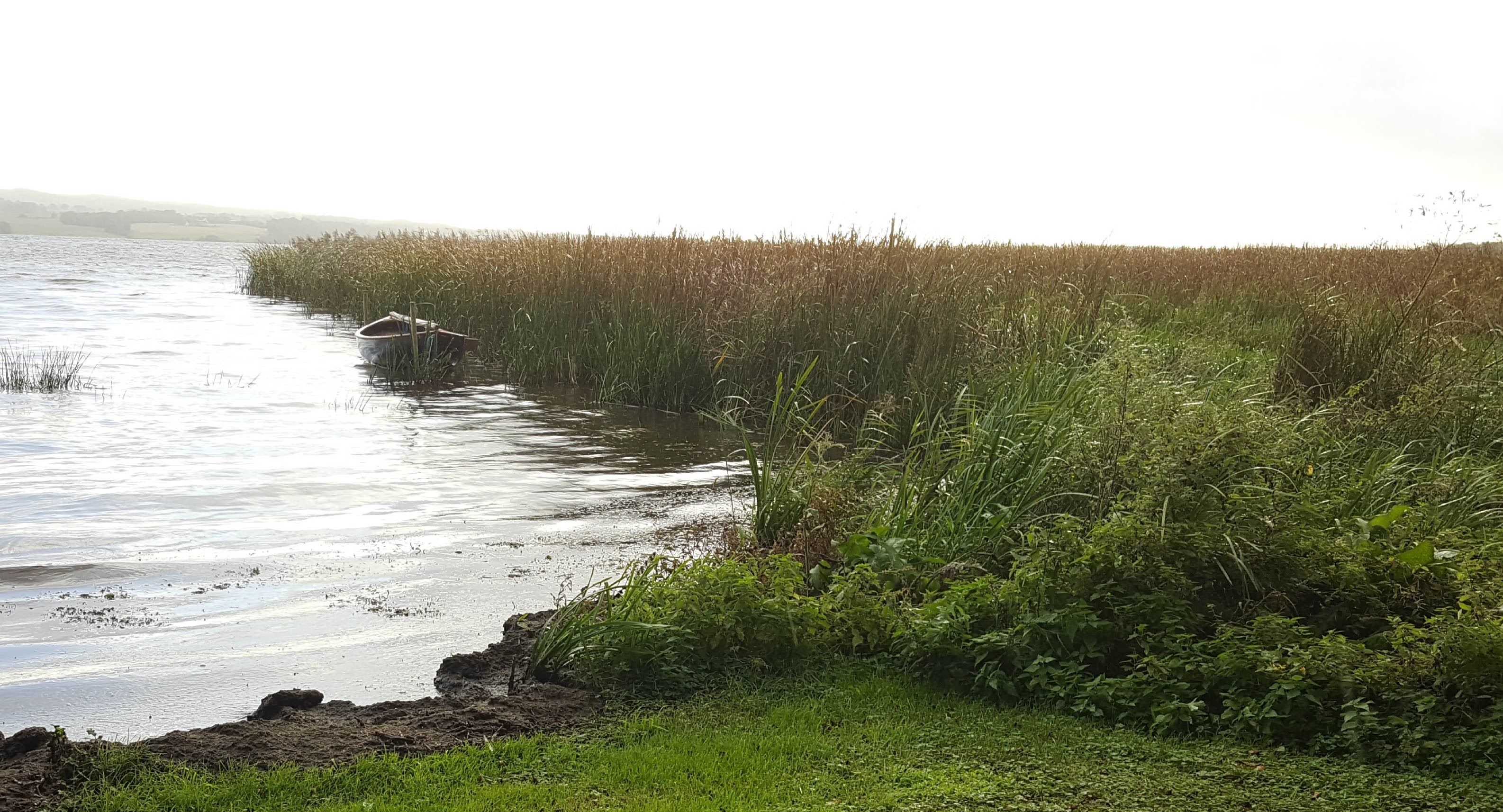
A lone rowboat on Mossø

A wind-blown, waving field of grain
Ry is a small resort on the commuter rail line between Aarhus and Silkeborg, the largest town in the Søhøjlandet. We had reserved a room for the night at the Ry Hotel, which looked quaint in its website photos but turned out to be more like a Holiday Inn. The hotel includes a conference center, which currently is undergoing renovation and expansion. (Rotary Club meetings are on the schedule for tomorrow.)
We had chosen the Hotel Ry not only because of its location but also because its restaurant had achieved good reviews. We passed up the Grill, (which serves mostly burgers) in favor of the more formal dining room, even though the abstract paintings on the walls weren’t what we would have chosen to hang there. Once again, we had to rely on Google’s translation app to make sense of the menu because the wait staff’s English did not allow them to adequately describe the appetizer plate Nancy chose–poultry terrine with bleu cheese, pickled beechnut, and truffles–nor the grilled walleye entrée that Michael ordered. Both of us decided to try another featured item on the Fall menu: græskar (pumpkin) risotto. Michael’s appetizer portion included pancetta; Nancy’s main-plate serving came with grilled vegetables. Some of the items on the dessert menu were not too difficult to figure out (Michael could spot the chocolate volcano cake with raspberry ice hidden within chokolade vulkankage med hindbær is), but Nancy had to wait until she tasted it to determine that the scoop of lakrids is accompanying her lemon torte was flavored with licorice.
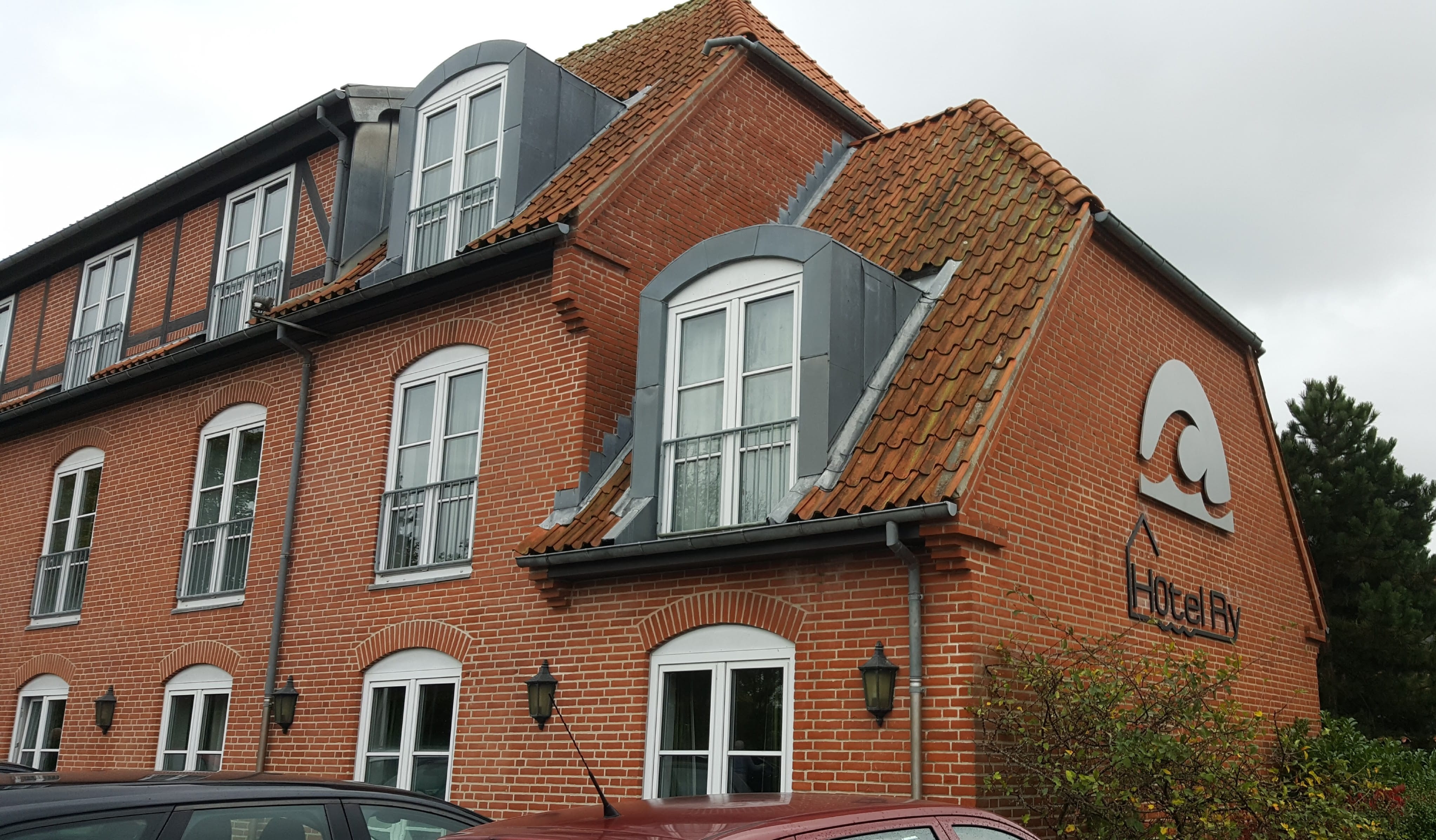
Our room at the Hotel Ry is on the end of the first level upstairs, under the sloping roof
Our room is on the first floor in the unrenovated wing of the hotel, in a corner under one of the dormer windows. It’s what might be described as “compact,” with a minimalist desk and clothes rack. The ceiling slopes along with the roof, so anyone taller than Nancy cannot stand in front of the bathroom sink without having to tilt his head. But at least the king-size bed (two twins shoved together under a common sheet and mattress pad) offers a comfortable horizontal surface on which to rest.
Leave A Comment